100 LIVING Russian artists you should know (PICS)

1. AES+F Group
Formed in 1987, the group took its name from the initials of its members’ surnames: Tatyana Arzamasova, Lev Evzovich, Yevgeny Svyatsky and Vladimir Fridkes, who joined later in 1995. In their photo projects and multi-channel video installations filmed in a mesmerizingly glamorous style, the artists construct apocalyptic scenarios of the future, analyze the language of modern media, and dissect social stereotypes to the point of absurdity.
Multiculturalism, the mutual influence of East and West, the cult of youth and beauty, ancient myths, homage to the great art of the Renaissance, technocracy and the triumph of feminism are just some of the themes they have covered in the last decade.
2. Tanya Akhmetgalieva
 Tatyana Akhmetgalieva. Fan of crystals #2
Tatyana Akhmetgalieva. Fan of crystals #2
A graphic artist and the creator of memorable installations in which embroidery from canvas intrudes into the surrounding space with “threads of memory”, Akhmetgalieva was born in Kemerovo, studied in St Petersburg, and lives and works in Russia’s two capitals.
 Tatyana Akhmetgalieva. Pupal stage
Tatyana Akhmetgalieva. Pupal stage
Her big debut came in 2010 at the Ural Biennale in Yekaterinburg. Since then, her work has been displayed in a handful of European galleries, and her vivid surrealist graphics have been shown in museums and galleries worldwide.
3. Yuri Albert
 Yuri Albert. ‘I am not Jasper Johns’, 1980
Yuri Albert. ‘I am not Jasper Johns’, 1980
Albert belongs to the new-wave generation of Moscow Conceptualism in the 1980s. He seeks to elucidate the key questions “What is art?” and “Who is an artist?”, and does so with a large dollop of irony.
 Yury Albert. Basic Colours ,1987
Yury Albert. Basic Colours ,1987
Clarifying the artist’s position in the art system, Albert wanders freely through the pages of art history, taking conventional notions and stereotypes to the point of absurdity.
4. Evgeny Antufiev
 Evgeny Antufiev. From the exhibition 'Twelve, wood, dolphin, knife, bowl, mask, crystal, bones and marble - fusion. Exploring materials'
Evgeny Antufiev. From the exhibition 'Twelve, wood, dolphin, knife, bowl, mask, crystal, bones and marble - fusion. Exploring materials'
Antufiev’s career began quite early and successfully. Having been spotted by art curators in Moscow at the tender age of 23, Antufiev was soon awarded the Kandinsky Prize for Best Young Artist and entered the international orbit, taking part in a number of European events, including the Manifesta Biennale in Zurich.
 Evgeny Antufiev. From the exhibition 'Twelve, wood, dolphin, knife, bowl, mask, crystal, bones and marble - fusion. Exploring materials'
Evgeny Antufiev. From the exhibition 'Twelve, wood, dolphin, knife, bowl, mask, crystal, bones and marble - fusion. Exploring materials'
In his works, we see the influence of shamanism, widespread in his native land of Tuva in southern Siberia, but in general the context is wider: the transformation of archaic myths and the actualization of magical consciousness.
5. Dmitry Aske
 Dmitry Aske's work at the Urban Morphogenesis street art festival, 2019
Dmitry Aske's work at the Urban Morphogenesis street art festival, 2019
He started painting graffiti in the 2000s, while also engaged in graphic design and illustration and authoring large-scale murals in Moscow, Vladivostok, Mannheim (Germany) and other cities. Having achieved popularity in street art, he moved on to successful gallery sales and major collaborations with famous brands (among them Nike and Sony).
 Dmitry Aske #1 from 'Day and Night' series, 2016
Dmitry Aske #1 from 'Day and Night' series, 2016
Recognizable works of recent years include his outdoor large-format sculptures and interior multilayer reliefs made from plywood with splashes of local color and mosaic images.
6. Andrey Bartenev
 Andrey Bartenev during the annual "Silver Galosh Awards", 2009
Andrey Bartenev during the annual "Silver Galosh Awards", 2009
Shock tactics are his specialty. Yet the provocation is always ironic, eye-catching and carnivalesque. Bartenev is the most extravagant artist in Russia, a fashion designer and showman, a one-man festival. He has designed costumes for theater performances from Moscow to New York, created multimedia installations and directed large costumed performances; dressed in surrealist attire, he himself is a “walking performance”.
 Composition "Worker and Kolkhoz Woman" at Andrei Bartenev's solo exhibition "Decoupage" in Korpus 3 gallery & concept store, 2009
Composition "Worker and Kolkhoz Woman" at Andrei Bartenev's solo exhibition "Decoupage" in Korpus 3 gallery & concept store, 2009
Painter, art producer, museum designer and illustrator are some of his other job titles.
7. Konstantin Batynkov
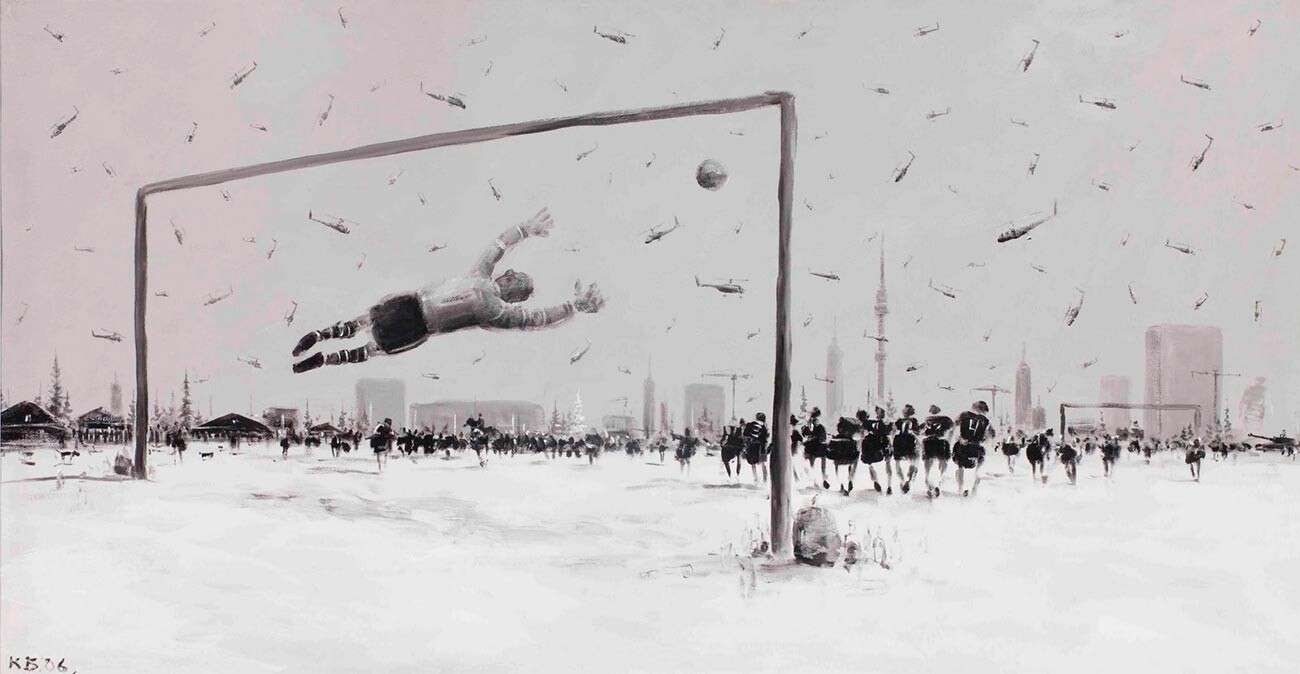 Konstantin Batynkov. From the GOAL series
Konstantin Batynkov. From the GOAL series
For many years, Batynkov's paintings and graphics were exclusively black and white. He put his monochrome style down to childhood impressions of watching black and white TV.
 Konstantin Batynkov. Kremlin, 2012
Konstantin Batynkov. Kremlin, 2012
Over time, color did seep into his works, but the subjects remained “boyish”: ships, planes, crowds of people against the backdrop of majestic landscapes. More romance than drama. That said, the subtexts in his works are far from naive.
8. Antonina Bayever
Bayever’s fields are video, installations, art objects and painting. She casts a critical eye on the contemporary context, creating ironic and absurd works based on real situations and modeling an alternative future.
Even in her graduate project, for instance, she explored corruption in the educational system by attempting to buy a fake diploma: the result was an animated film with real dialogue. Her subsequent videos reflect the theme of TV shows, 1960s aesthetics, the new wave in cinema, social and gender inequality, and 1990s pop culture.
9. Peter Belyi
 Peter Belyi. Silence
Peter Belyi. Silence
This St. Petersburg-born artist’s youth coincided with perestroika and its constantly shifting paradigms. His personal response to this was a preoccupation with disappearing material culture. Peter himself describes his method as "memorial modeling", implying the deconstruction and reinterpretation of former patterns.
 Peter Belyi. The Source, 2013
Peter Belyi. The Source, 2013
At the turn of the new millennium, he lived in London, but has since returned to his hometown. In the last 15 years, he has also made a name for himself as a curator and researcher of visual culture.
10. Sergey Bratkov
 Sergei Bratkov. Wow, 2016
Sergei Bratkov. Wow, 2016
The Kharkov school of photography, led by the renowned Boris Mikhailov, had a great influence on this photographer and artist. Developing in the 1960s and 70s, the school stood out for its focus on social topics and unseemly subjects not suitable for Soviet newspapers and magazines.
 Sergei Bratkov. Hundred. From the "The Empire of Dreams" 2017
Sergei Bratkov. Hundred. From the "The Empire of Dreams" 2017
Bratkov’s early works documented the reality around him, but he soon moved on to creating collages, art objects and installations with photography. In an ironic and poetic way, the artist raises the themes of searching for one’s identity, the militarization of society and the power of consumerism and advertising.
11. Alexander Brodsky
 Alexander Brodsky. Artwork from PO-2 at the Archstoyanie 2018 festival
Alexander Brodsky. Artwork from PO-2 at the Archstoyanie 2018 festival
An architect by training, in the 1980s he was one of the key figures in the “paper architecture” trend, a late Soviet-era phenomenon whereby talented architects escaped from dull reality by designing imaginary buildings that invariably created a stir at international competitions.
 Alexander Brodsky. Rotunda in Nikola Lenivets art park, 2009
Alexander Brodsky. Rotunda in Nikola Lenivets art park, 2009
In the post-Soviet period, Brodsky found an outlet for his fantasies: total installations, art objects that shape the space around, including parks. As an artist, his interest lies in the impermanence and fragility of memory, both personal and collective; he builds unstable bridges to the Soviet past and childhood memories, speaks of a lost culture and the passing of time, and does so with subtlety and precision, playing in semitones.
12. Grigory Bruskin
 Grisha Bruskin. Fundamental Lexicon, 1986
Grisha Bruskin. Fundamental Lexicon, 1986
World fame came to this artist in 1988 after a Sotheby’s auction in Moscow. His Fundamental Lexicon series was the top lot, selling for £242,000, more than 10 times the expected price. Just a few months before that, film director Milos Forman had bought the first part of Lexicon for just 2,000 rubles.
 Grisha Bruskin. Fundamental Lexicon
Grisha Bruskin. Fundamental Lexicon
A year later, the artist moved to the U.S. and now divides his time between New York and Moscow. His favorite device is the dictionary structure: the world is like a book in which the Old Testament and Soviet mythology are woven together. He transforms the cultural memory of multiple generations into a piece of theater acted out in front of the viewer by symbolic figures.
13. Erik Bulatov
 Erik Bulatov. Glory to CPSU, 2002-2005
Erik Bulatov. Glory to CPSU, 2002-2005
Bulatov is considered both a founder of Sots Art (aka Soviet Pop Art) and a pioneer of Moscow Conceptualism. The import of his work lies at the intersection of text and image: his objet d’art pictures, starting from the 1970s, portray ubiquitously regulated Soviet life, full of precepts and prohibitions.
 Erik Bulatov. That Is What It Is. 2000
Erik Bulatov. That Is What It Is. 2000
Typical postcard landscapes are overlaid symbolically with texts from everyday life: "No Entry", "Glory to the CPSU", "Welcome". After emigrating to France, the Soviet slogans were replaced by lines of poetry, and the general tone of this classic artist became more cheerful.
14. Olga Chernysheva
 Olga Chernysheva. From the Fishermen-Plants (Anabiosis) series, 2000
Olga Chernysheva. From the Fishermen-Plants (Anabiosis) series, 2000
“I reveal the absurd roots of normality,” Olga clarifies when she is labeled a realist artist. Absurdity is the basis, the linchpin, that runs through almost all of her works, whether it’s a painting of skyscraper window cleaners or a photograph with crystal chandeliers in woodland by the highway.
 Olga Chernysheva. Untitled. From the Plots series, 2005
Olga Chernysheva. Untitled. From the Plots series, 2005
Chernysheva is one of the most marketable Russian artists in the world, whose work has featured in the main program of the Venice Biennale and at Manifesta in Zurich. Exhibitions of her work have been held from Moscow to London and New York.
15. Aristarkh Chernyshev
 Aristarkh Chernyshev. Antique Head, 2021
Aristarkh Chernyshev. Antique Head, 2021
This pioneer of media art in Russia began his creative career in 1991. His art objects, technological and often interactive, make use of 3D printing, video, VR, AR and other technologies, often venturing into the realm of sci-fi. He invents new gadgets and services linked to the future development of social networks, genetic engineering and artificial intelligence.
Notable new projects include PiO (personal informational organism) – a leech/smartphone hybrid that lives on the owner’s wrist, feeds on their blood and monitors their health in return.
16. Valeriy Chtak
 Valeriy Chtak. I don't know - I'm from Moscow, 2019
Valeriy Chtak. I don't know - I'm from Moscow, 2019
The charm of Chtak’s textual pictures lies in their frequent yet unobtrusive absurdity. For example: “Kung fu is not Marxism – either you know it or you don’t” or “I don’t know, I’m from Moscow.”
 Valeriy Chtak. Untitled, 2010
Valeriy Chtak. Untitled, 2010
Random phrases are seemingly snatched from the stream of street talk; sometimes amid such absurdity a kind of wisdom can be glimpsed. The aesthetics of street art and the performativity of gesture are perceptible in both the artist’s signature canvases and his installations.
17. The Collective Actions Group
 The Collective Actions Group. 'Ball' action. 1977
The Collective Actions Group. 'Ball' action. 1977
The group was founded in the mid-1970s by conceptualist Andrey Monastyrsky. Its membership was fluid, and specially invited viewers could join the group’s actions (interestingly, such inclusivity became a major trend in contemporary art).
 Andrey Monastyrsky and The Collective Actions Group's installation
Andrey Monastyrsky and The Collective Actions Group's installation
CA staged actions outside Moscow, in nature’s lap, where they could not be tracked by the authorities. Their actions were mostly absurdist, more like mystical rituals or spiritual practices, in which the participants followed specially prescribed instructions.
18. Vladimir Dubossarsky
 Vladimir Dubossarsky's exhibition 'Grandpa Tales'. Untitiled from the 'Animal world' series
Vladimir Dubossarsky's exhibition 'Grandpa Tales'. Untitiled from the 'Animal world' series
A painter and creator of large-scale canvases that invariably reproduce a happy world, a luxurious utopia, a dream or reverie. From 1994 to 2014 he collaborated with Alexander Vinogradov, whose artistic duo was one of the most striking phenomena of post-Soviet art, reflecting the moods and tastes of three decades: the “wild” 1990s, the “fat” 2000s and the crisis-ridden 2010s.
 Vladimir Dubossarsky's exhibition 'Grandpa Tales'. Untitiled from the 'Animal world' series
Vladimir Dubossarsky's exhibition 'Grandpa Tales'. Untitiled from the 'Animal world' series
His solo work continues to paint a portrait of our time, including an exploration of social networks and a rethinking of the Soviet past.
19. Elena Elagina and Igor Makarevich
 Igor Makarevich & Elena Elagina. Tsiolkovsky. From the 'Portraits of Russian cosmists' series, 2009
Igor Makarevich & Elena Elagina. Tsiolkovsky. From the 'Portraits of Russian cosmists' series, 2009
This pair of conceptualists formed a duo in 1990. Their art is based on pseudo-scientific research and mystification, in which real and made-up facts and characters are intertwined.
 Igor Makarevich & Elena Elagina. Buratino Formula. From the Life in the Snow series, 1993-2003
Igor Makarevich & Elena Elagina. Buratino Formula. From the Life in the Snow series, 1993-2003
Oftentimes, the projects refer to avant-garde art and its utopian ideas. The artists themselves designate their creative method as “a combination of extreme mysticism and extreme materiality.”
20. Semyon Faibisovich
 Semen Fajbisovich. MKAD (from the cycle Shuttle Bus), 1984
Semen Fajbisovich. MKAD (from the cycle Shuttle Bus), 1984
By the late 1970s, Faibisovich was a prominent figure in the pleiad of unofficial Moscow artists. And with the onset of perestroika, his photorealistic painting attracted the attention of Western galleries, which resulted in numerous exhibitions in the U.S. and Europe.
 Semen Fajbisovich. Girlfriends from the cycle «On the benches», 1989
Semen Fajbisovich. Girlfriends from the cycle «On the benches», 1989
His images of Soviet reality were slowly replaced by post-Soviet themes, and pure painting gave way to experiments with photographic optics and mobile photography. “An artist must live in his own time, that is his main value and resource,” Faibisovich believes.
21. Egor Fedorichev
 Egor Fedorychev. And let the north wind blow, we make our inevitable just do it
Egor Fedorychev. And let the north wind blow, we make our inevitable just do it
This artist often employs as his canvas used industrial materials, such as tarpaulin or banner cloth. In line with the deliberate carelessness in the execution (painting on roughly stitched pieces of fabric; leaving finished canvases without frames, freely hanging from the wall or ceiling), the “subjects” of his works (figurative images painted in thick strokes) are mixed with a garish abstract background.
 Egor Fedorichev. About unrequited love for the motherland №2, 2018
Egor Fedorichev. About unrequited love for the motherland №2, 2018
Fedorichev's paintings call to mind an ancient scroll in which the turbulence of our time is reflected.
22. Ilya Fedotov-Fedorov
 Ilya Fedotov-Fedorov. Health catcher totem, 2019
Ilya Fedotov-Fedorov. Health catcher totem, 2019
“For me, nature is integral to the theme of finding oneself,” says the artist, who came to art from a bioengineering background. Indeed, the personal inner world, the environment and technology have been the main focus of his work for the past seven years or so.
Nature is also the primary supplier of materials for his works, executed in a variety of forms, from photography and video to assemblages and installations.
23. Artem Filatov
 Artem Filatov. 'Back Home' exhibition at Nizhny Novgorod Intelligentsia Museum
Artem Filatov. 'Back Home' exhibition at Nizhny Novgorod Intelligentsia Museum
This artist and activist hailing from Nizhny Novgorod works with the local context and urban identity. He began with street art. painting the walls of abandoned wooden houses so as to draw attention to the commonplace buildings that make up the living fabric of the old city. Through his efforts, some of them were subsequently restored.
He is a two-time winner of the Innovation Prize, a Russian art award: in 2017 for his exhibition in the empty halls of the former Museum of the Nizhny Novgorod Intelligentsia (together with a group of artists he created an all-encompassing installation around the city’s urban myths), and in 2020 for his sound installation project with Alexey Corsi in the crematorium of his hometown.
READ MORE: How a street artist is changing the face of this ancient Russian city
24. Sergey Filatov
His sound installations are assembled from a wide variety of materials and mechanisms, but the emphasis is on sensory perception. The artist invites the viewer to plunge into the sound environment he has created, which makes getting to know his work similar to meditation.
During his experiments, Filatov invented an alternative method of sound production as well as a new musical instrument: the electrolyre. Its strings are moved not by hand or bow, but by a magnet whose movement is pre-programmed. A simplified version, the two-stringed instrument Duofluctus, is used by musicians worldwide; Filatov presented it in the main program of the 58th Venice Biennale in 2019 as part of an installation by French artist Tarek Ataui.
25. Andrey Filippov
 Andrei Filippov. Christ is risen, 2010
Andrei Filippov. Christ is risen, 2010
A graduate of the Moscow Art Theater School and a representative of the conceptual school, Filippov thinks spatially, each of his exhibitions turning into an installation regardless of the technique employed. He often invokes the imperial consciousness through the use of double-headed eagles or religious symbols, which also form part of his imperial thinking.
 Andrei Filippov. The Last Supper, 2016
Andrei Filippov. The Last Supper, 2016
For instance, his “Last Supper” installation featured a red tablecloth with hammers and sickles serving as cutlery.
26. Ian Ginzburg
 Ian Ginsburg. The Mechanical Beetle
Ian Ginsburg. The Mechanical Beetle
This artist continues the traditions of Moscow Conceptualism, exploring the theme of memory and personal myth-making. His surname is a pseudonym borrowed from Joseph Ginzburg, an outsider artist of the 1960s with a tragic fate.
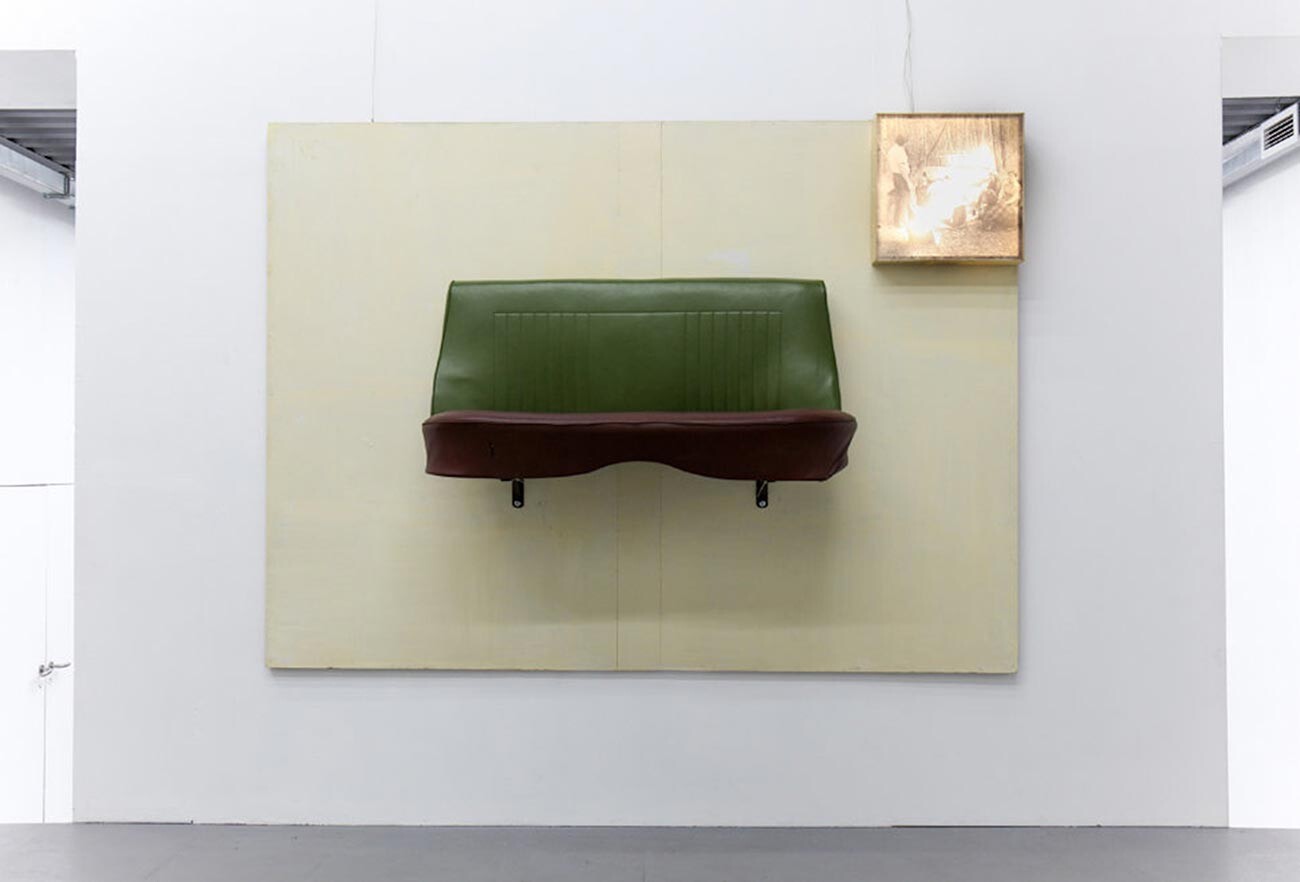 Ian Ginsburg. The Mechanical Beetle
Ian Ginsburg. The Mechanical Beetle
The young Ian Tamkovich (his real name) met the latter shortly before his death. He dreamed of making an exhibition of his work and ended up inheriting his archive and surname. This acquaintance gave rise to a number of installations and exhibitions dedicated to Soviet art of the 1960s and 70s and its main players.
27. Aslan Goisum (Gaisumov)
 Aslan Gaisumov. Untitled/War
Aslan Gaisumov. Untitled/War
For Aslan Goisum, born in Grozny in 1991, the Chechen wars are not historical events, but personal experiences. The terrible events of his childhood, intermingled with local history and other eyewitness accounts, Goisum presents through his installations, readymades and videos in documentary or metaphorical form, as in the mutilated books of his “Untitled (War)” series.
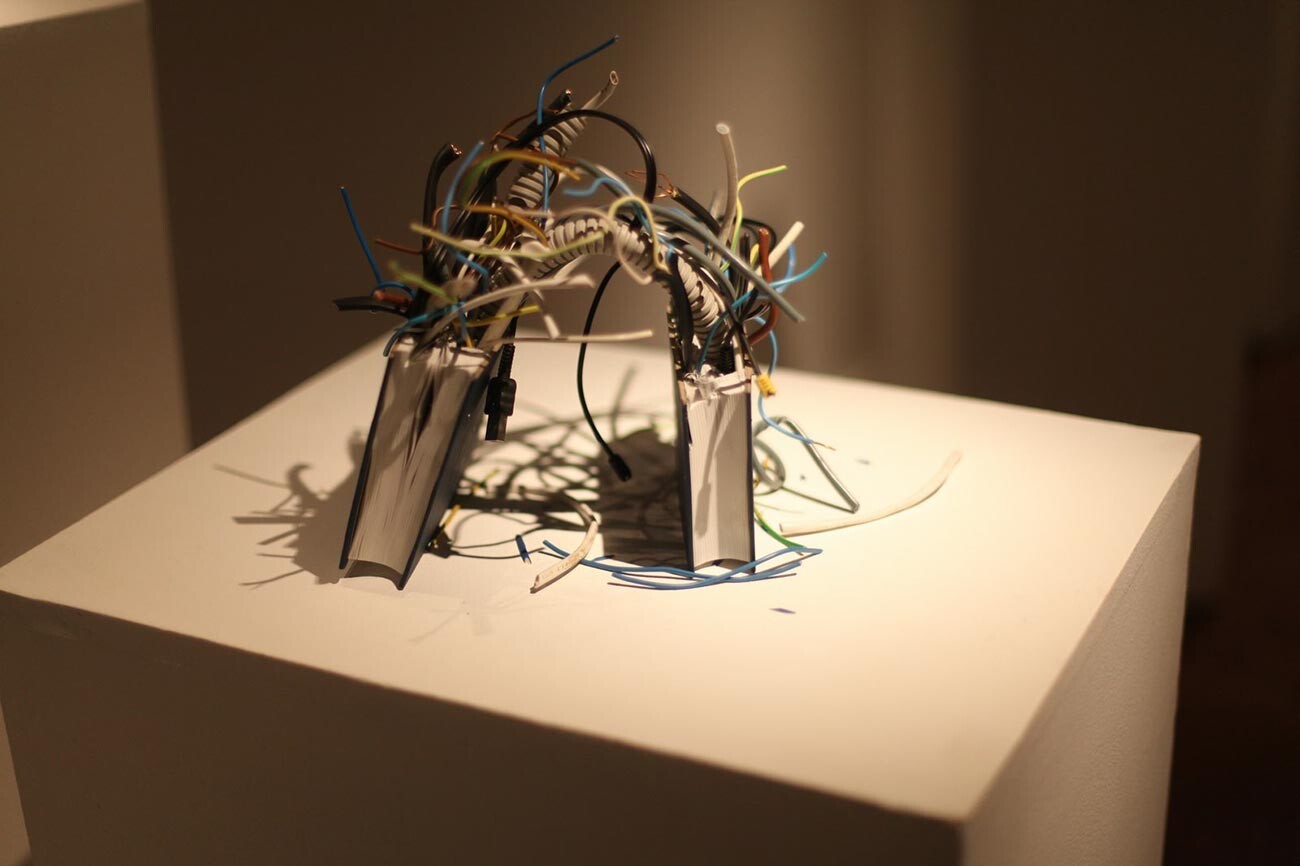 Aslan Gaisumov. Untitled/War
Aslan Gaisumov. Untitled/War
It was with this that Goisum, today recognized on the European art scene, made his debut in Moscow back in 2011.
28. Ivan Gorshkov
 Ivan Gorshkov at the Garage Triennial of Russian Contemporary Art, A Beautiful Night for All the People
Ivan Gorshkov at the Garage Triennial of Russian Contemporary Art, A Beautiful Night for All the People
This artist from Voronezh has a variety of materials and techniques at his fingertips, moving freely from painting to sculpture, from animation to public art. He calls his style "semi-abstract expressionism", implying that it is largely based on 20th-century modernist forms. The author attaches great importance to the materiality of his works.
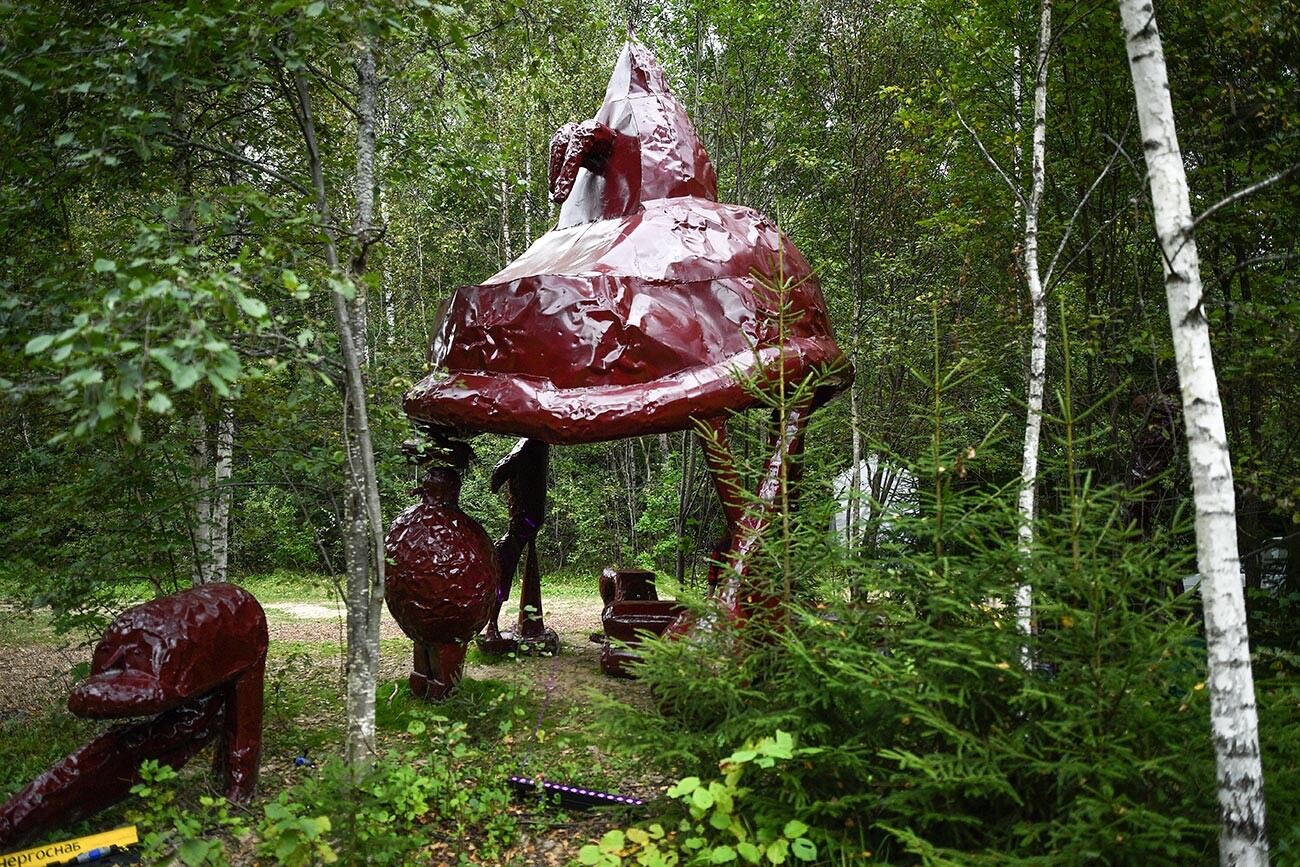 Gazebo pavillion by Ivan Gorshkov at Nikola-Lenivets art-park
Gazebo pavillion by Ivan Gorshkov at Nikola-Lenivets art-park
His most characteristic are brutal, at times grotesque sculptures made of welded metal. He has become an increasingly prominent figure on the international art scene in recent years.
29. Yevgeny Granilshchikov
Starting his career in the 2000s as a photographer, Yevgeny was immediately attracted to video art and film directing. Going forward, short films would form the basis of his style. In his own words, Granilshchikov "re-enacted everyday life in the 1910s." That said, he is not limited to screen forms and has a liking for multimedia installations. He is a laureate of the Kandinsky Prize for Best Young Artist (2013), and a regular participant in international exhibitions and auteur film festivals.
30. Dmitry Gutov
 Dmitry Gutov. The Corridor of Two Banalities
Dmitry Gutov. The Corridor of Two Banalities
This intellectual artist and staunch Marxist is an admirer of the ideas of Marxist philosopher Mikhail Lifshitz. In homage to his idol, Gutov attempts to restore the true meaning of Marxist aesthetics, placing it on the international agenda, where leftist discourse is in demand like never before.
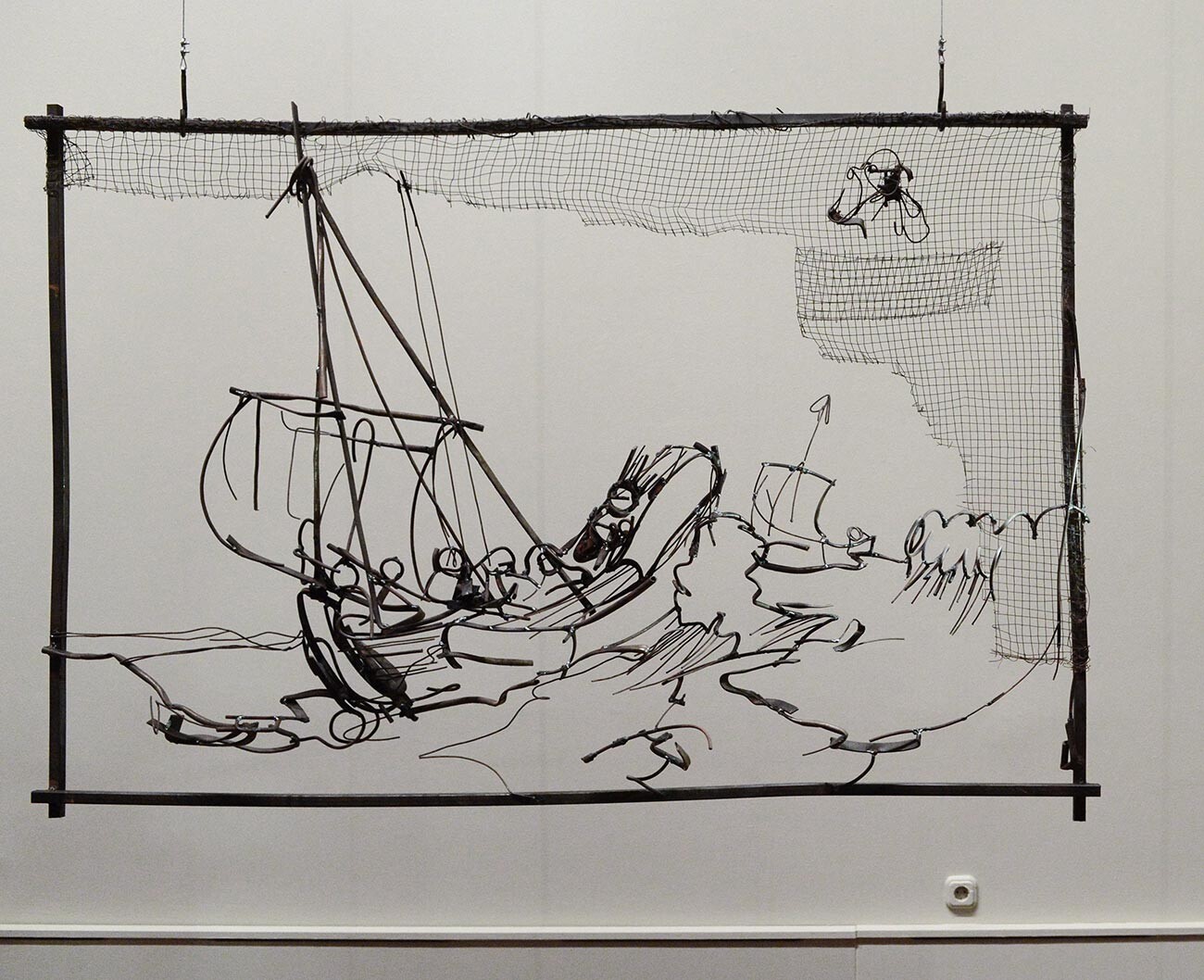 "Rembrandt - a Different Perspective. Pieces by Rembrandt van Rijn and Dmitry Gutov" exhibition
"Rembrandt - a Different Perspective. Pieces by Rembrandt van Rijn and Dmitry Gutov" exhibition
His art is largely an illustration of Marx’s ideas as interpreted by Lifshitz. Equally, while criticizing modernism from a Marxist standpoint, Gutov feels quite at ease on postmodernist territory.
31. Francisco Infante-Arana
 Francisco Infante-Arana. Artifacts from the "Processions" series, 1978
Francisco Infante-Arana. Artifacts from the "Processions" series, 1978
Infante-Arana’s art gained momentum in the 1960s, a time of space exploration and a new phase of the scientific and technological revolution. The artist was one of the originators of kinetic art in the USSR. He soon founded his own group, Argo, one direction of which was the planning of "space architecture".
 Francisco Infante-Arana. Artifacts from the "Continues" series, 1992
Francisco Infante-Arana. Artifacts from the "Continues" series, 1992
Since the late 1960s, Infante-Arana has preferred to work in tandem with his wife Nonna Goryunova. Besides his kinetic works, he is famous for his “artifacts” – optical objects embedded in the natural environment. This transformed reality is captured in photography.
32. Ilya and Emilia Kabakov
 Ilya and Emila Kabakov. They are Painting the Boat, 2015
Ilya and Emila Kabakov. They are Painting the Boat, 2015
The married duo of Ilya and Emilia Kabakov have been working together creatively since the early 1990s. However, Ilya’s story dates back much earlier, to the 1970s, when his studio became a laboratory of Moscow Conceptualism.
 Ilya and Emilia Kabakov, 'Not Everyone Will Be Taken into the Future' exhibition, 2018
Ilya and Emilia Kabakov, 'Not Everyone Will Be Taken into the Future' exhibition, 2018
Despite living in the U.S. for the past 30 years, Kabakov still holds the title of "number one Russian artist". And with good reason: after all, it was he who vividly conveyed the atmosphere of the communal world of the Soviet era, and, more significantly, found a visual language intelligible to the international audience. Art is also indebted to Kabakov for inventing the “total installation” genre.
33. Polina Kanis
Kanis creates videos and installations that examine the hidden mechanisms of social transformations, labor relations and their emotional and psychological impact on humans in the Anthropocene Epoch.
Kanis’ staged videos, featuring professional and amateur actors, explore the gap between the real world and the social construct, revealing the fragility of existence. She is the recipient of some prestigious Russian art awards.
34. Alyona Kirtsova
 Alyona Kirtsova. Landscape #6. From the 'Color Guide' series. 2006
Alyona Kirtsova. Landscape #6. From the 'Color Guide' series. 2006
Her career began in the Soviet period with underground exhibitions of unofficial art. However, Kirtsova's work never contained any political or social overtones. The early 1980s saw the appearance of her trademark technique, in which life observations and sensory experience peer out from behind geometric abstraction.
 Alyona Kirtsova. Landscape #4 N. From the 'North' series. 2010
Alyona Kirtsova. Landscape #4 N. From the 'North' series. 2010
Perhaps her main canvas is of the laconic nature of the Russian North. In addition to painting, Kirtsova works in the fields of graphics, photography, installations and land art.
35. Vitaly Komar
 Komar & Melamid. Friendship of nations # 107, 1974
Komar & Melamid. Friendship of nations # 107, 1974
Vitaly Komar and Alexander Melamid are the founding fathers of the most ironic Soviet art movement: Sots Art. Having worked side by side for many years, the artists became known under a double-barrelled last name. Sots Art was the Soviet cousin of Pop Art. While Pop Art mimicked advertising, criticizing consumer culture, Sots Art merged with the aesthetics of the Soviet poster as ideology advertising.
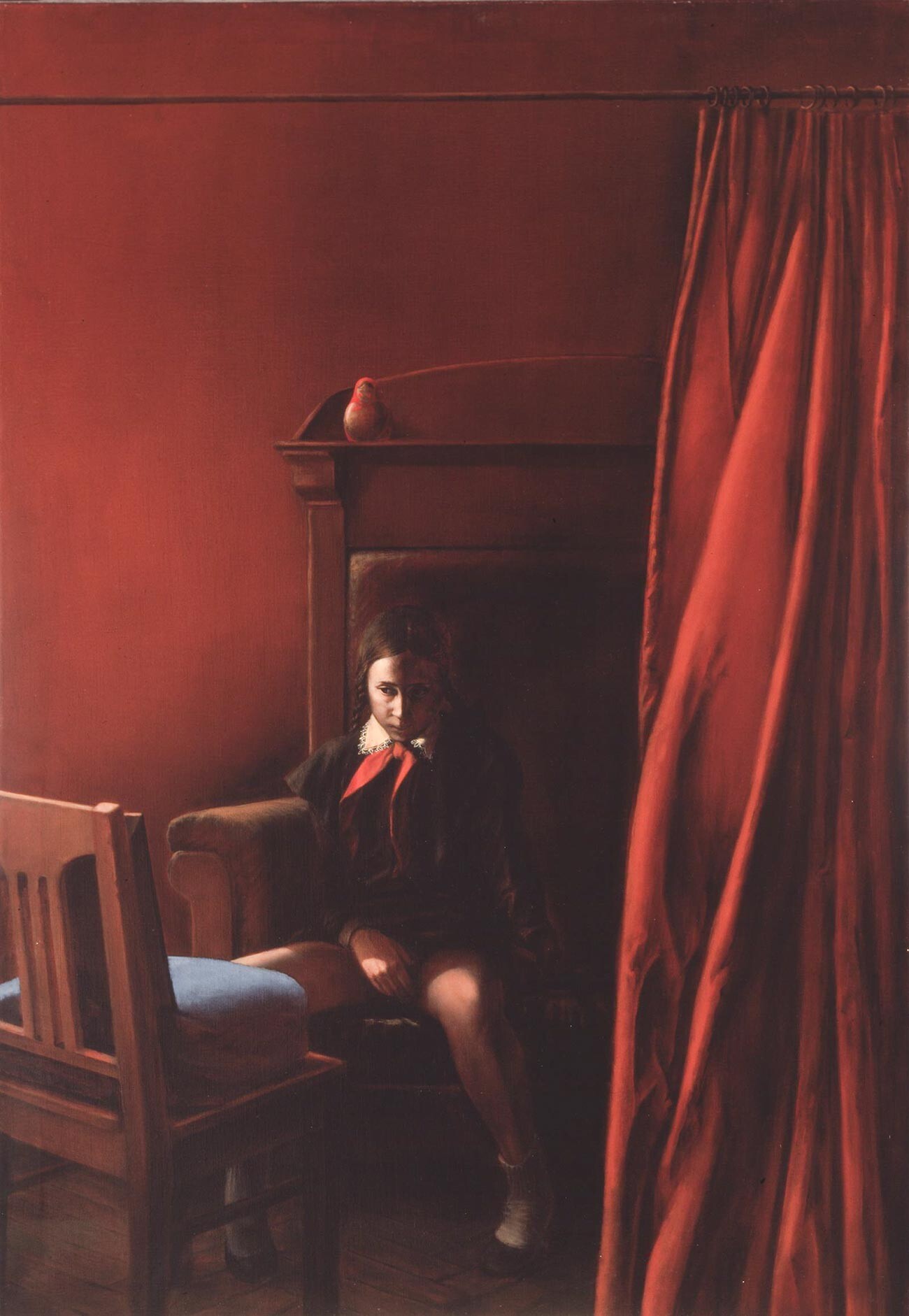 Komar & Melamid. Girl in Front of a Mirror , 1981–1982
Komar & Melamid. Girl in Front of a Mirror , 1981–1982
In the late 1970s, they emigrated, continuing their collaboration in the U.S. After breaking up with Melamid, Komar turned to geometric abstraction, a serious and monumental genre, which made it possible to manifest himself as a real, not make-believe painter.
READ MORE: Russian artists who created Soviet memes
36. Irina Korina
 Irina Korina. Resting columns
Irina Korina. Resting columns
A set designer by training, Korina has worked in theater and cinema for more than twenty years, where she deploys "theatrical optics" in her artistic practice. Her art objects and installations are easy to imagine as part of a fictional performance involving the viewer. She uses unusual materials – banner cloth, polycarbonate, plastic, tiles, paper.
 Irina Korina's "Grove" installation at the Futurologia exhibition in the Garaga Museum of Contemporary Art
Irina Korina's "Grove" installation at the Futurologia exhibition in the Garaga Museum of Contemporary Art
The ordinary and the fantastical, kitsch and aestheticism collide in her works, which she seems to create from everything she sees around, reassembling the DNA of Russian reality, and doing so charmingly and lovingly. Twice she has participated in the Venice Biennale: in the Russian pavilion (2009) and the core exhibition (2017).
37. Taisiya Korotkova
 Taisiya Korotkova. Closed Russia project
Taisiya Korotkova. Closed Russia project
Korotkova combines an interest in science with knowingly traditional, almost archaic painting. This mix raises certain doubts in the viewer as to the beneficial nature of progress – and this is part of the artist's task. She does not condemn, but asks questions.
 Taisiya Korotkova. Closed Russia project
Taisiya Korotkova. Closed Russia project
Her long-term series are gradually shaping into a single super-project. In 2010, Taisiya received the Kandinsky Prize for Best Young Artist. She lives in Italy, but is actively present on the Moscow art scene.
38. Yegor Koshelev
 Egor Koshelev. Guessing from the «Bird Series», 2020
Egor Koshelev. Guessing from the «Bird Series», 2020
Not every professional painter gets involved in street art, but that’s what happened to Muscovite Yegor Koshelev. Later he retained this propensity for combining the high and the low, the popular and the elite. His paintings are full of mixes and paradoxes; social criticism is not uncommon in his works, but it is never without a philosophical context bordering on the absurd.
 Egor Koshelev. Big cut, 2018
Egor Koshelev. Big cut, 2018
At times the author intentionally marginalizes the traditions of academic painting, striving for maximum resonance of his statement.
39. Valery Koshliakov
 Valery Koshliakov. Untitled, 2000
Valery Koshliakov. Untitled, 2000
The large-format painting of the “Russian art’s main romanticist” resembles time-worn frescoes. He creates great architecture (or the memory of it) using intentionally “poor” materials: cardboard, kraft paper, normal paper, connecting the sheets with mounting tape, diluting the acrylic or tempera to the state of blotches on the surface.
 Valery Koshliakov. USSR, 2006
Valery Koshliakov. USSR, 2006
The fragility and instability of the materials echo these same properties of the great empires viewed historically, be it the Greco-Roman world, the Middle Ages with their Gothic cathedrals, or the Soviet Union with its Stalinist skyscrapers.
40. Alexander Kosolapov
 Alexander Kosolapov. Malevich, 1993
Alexander Kosolapov. Malevich, 1993
One of the leading representatives of Sots Art, Kosolapov emigrated to the U.S. in the mid-1970s. The artist makes active use of the language of advertising, so that his works sometimes resemble online memes, despite being made long before the Internet went mainstream. Kosolapov’s main interest is criticism of ideologies, often appearing as satire, which can cause outrage.
 Alexander Kosolapov. Coca-Cola, 1983
Alexander Kosolapov. Coca-Cola, 1983
The most high-profile example was the picture “Lenin-Coca-Cola”, which resulted in the powerful corporation suing the artist for illegal use of its logo and propaganda of communism.
41. Olga Kroytor
 Olga Kroytor. Fulcrum performance
Olga Kroytor. Fulcrum performance
Even if Kroytor had done nothing else besides "Fulcrum", a piece of performance art in which she stood motionless for hours atop a tall wooden pillar, modern art would still remember her forever. The viewer can seek cultural allusions in her works or not, the choice is theirs. But what no one can fail to spot is the attempt to visualize and transcend the universal human experience.
 Olga Kroytor. Untitled (open grave) performance
Olga Kroytor. Untitled (open grave) performance
“When pain points are stretched to the absolute, the problematics eventually subside,” says this leading exponent of performance art in Russia.
READ MORE: This Russian beauty does some pretty bizarre performance art
42. Oleg Kulik
 Oleg Kulik. “Mad dog” video performance
Oleg Kulik. “Mad dog” video performance
A legend of the Moscow Actionism movement, Kulik became famous for his shock-jock “mad dog” performances: naked, on a leash, he would bark and throw himself at passers-by and gallery-goers. He staged his first such action in 1994 in central Moscow, and over the next four years the “man-dog” toured Zurich, Vienna, Berlin, Paris, New York and other cities.
 "A Tennis Player" installation by Oleg Kulik displayed at the exhibition "The 2000s: Selected Works from Yekaterina and Vladimir Semenikhin Collection. 2000-2005."
"A Tennis Player" installation by Oleg Kulik displayed at the exhibition "The 2000s: Selected Works from Yekaterina and Vladimir Semenikhin Collection. 2000-2005."
In the 2000s he worked with installations: the most famous being the “Tennis Player”, depicting a wax Anna Kournikova leaping in mid-stroke, complete with taxidermic stitches: the work explores the transformation of living nature and culture into a man-made zoological museum, where stuffed animals are dead and harmless. Today he experiments with photo collage and painting.
43. Alexander Kutovoy
 Alexander Kutovoy. Lenin - Hill, 2015
Alexander Kutovoy. Lenin - Hill, 2015
His sculptures make use of both traditional materials (clay, bronze, ceramics, marble) and modern technologies (plastic, 3D printing). He addresses the contemporary media agenda, rethinking it with a large slice of irony and criticism, and explores the system he lives in and ways to bring about its transformation.
 Alexander Kutovoy. Untitiled, 2021
Alexander Kutovoy. Untitiled, 2021
Thus, the commonplace desire for an ideal body and passion for healthy living resulted in the large-scale project “Bulky Biceps Trying To Fly”, which turns classic antique sculptures into sports equipment. In other projects, Kutovoy studies human free will in rigidly programmed conditions: anthropomorphic figures made of not fully hardened clay acquire a new identity right there at the exhibition as a result of any interaction with them.
44. Andrey Kuzkin
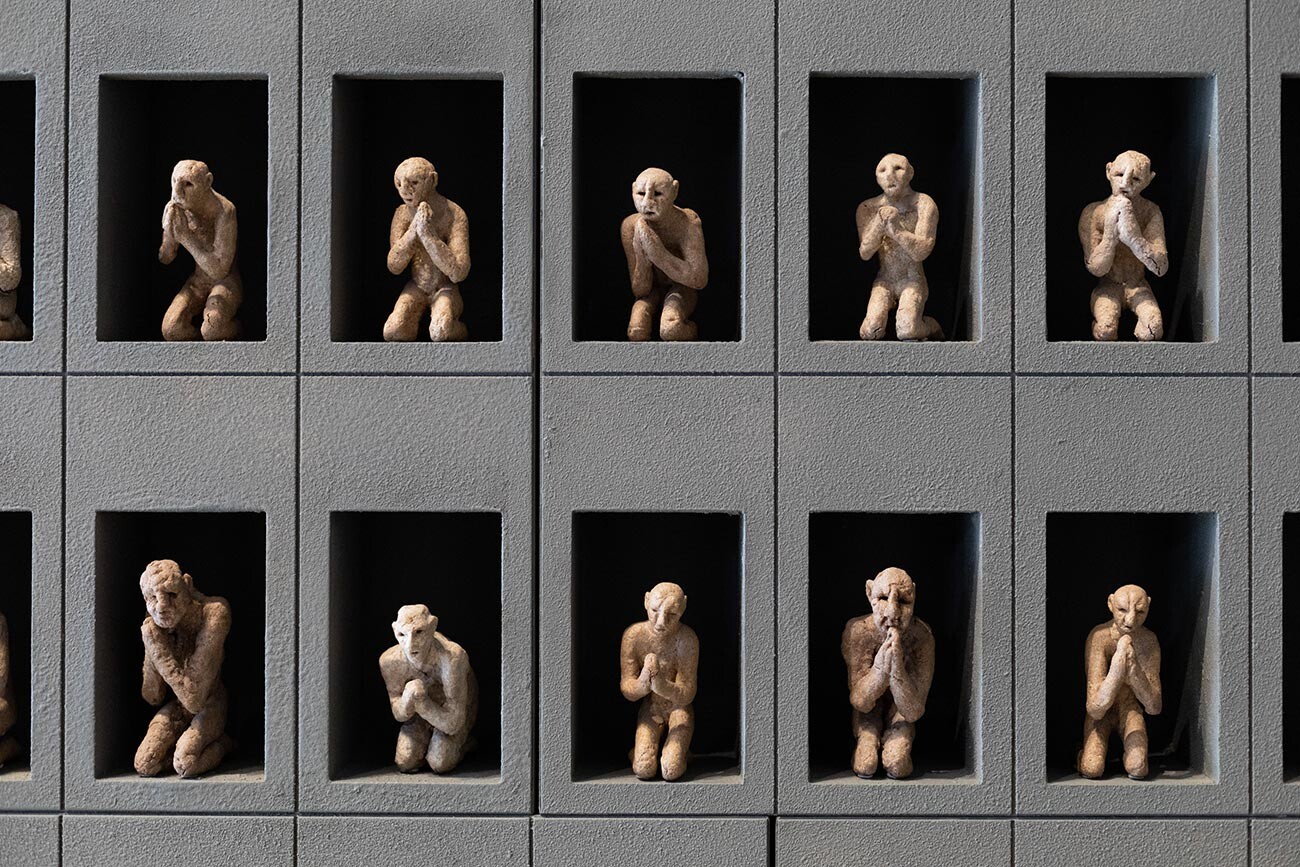 Andrei Kuzkin's works at the Garage Triennial of Russian Contemporary Art, A Beautiful Night for All the People, 2020
Andrei Kuzkin's works at the Garage Triennial of Russian Contemporary Art, A Beautiful Night for All the People, 2020
Kuzkin burst onto the art scene in 2008 with his “In a Circle” performance: for one hour, the artist, roped to a peg, walked in a circle in a pool filled with liquid concrete. After that, he was mooted as one of the most promising young artists, and all his subsequent performances and exhibitions, including at the Venice Biennale, only consolidated this view.
 Andrei Kuzkin's work at the Garage Triennial of Russian Contemporary Art, A Beautiful Night for All the People, 2020
Andrei Kuzkin's work at the Garage Triennial of Russian Contemporary Art, A Beautiful Night for All the People, 2020
No less famous are his sculptures made of bread: the ideal material for existential themes. Bread in Christianity symbolizes the sacrifice and body of Christ; moreover, in Russia it is a symbol of satiety and a traditional material from which prisoners sculpt figures.
READ MORE: This Russian artist makes sculptures from bread
45. Georgy Litichevsky
 Georgy Litichevsky. Solo show "Intelligence of Flowers". Installation view at Iragui gallery, 2020
Georgy Litichevsky. Solo show "Intelligence of Flowers". Installation view at Iragui gallery, 2020
Once a serious historian, Litichevsky spent his spare time drawing comics. And this passion got the better of his academic side. He joined the ranks of artists promoting the new aesthetics of the 1990s.
 Georgy Litichevsky. Treble Clef, 2013
Georgy Litichevsky. Treble Clef, 2013
Fame came to him during perestroika as a member of the Detsky Sad (“Kindergarten”) art squat in Moscow, which for him was about creating his own version of the New Wave trend. His manner having changed, he added both performance art and multimedia installations to his resume, yet comics remain the hallmark of his "corporate style".
46. Artyom Loskutov
 Artyom Loskutov. Prohibited goods on a red background "Let those who have the old paintings bad, paint the new ones", 2017
Artyom Loskutov. Prohibited goods on a red background "Let those who have the old paintings bad, paint the new ones", 2017
Fame came to Loskutov when still a student at Novosibirsk University. In his native city, the artist initiated the now annual “Monstration” street processions: columns of young people in bizarre outfits march through the city, unfurling Dadaist slogans and posters in celebration of the absurd.
 Artyom Loskutov. America, 2020
Artyom Loskutov. America, 2020
Later he moved to Moscow, where he took on solo projects at the intersection of actionism, public art and political activism.
47. Boris Matrosov
 Boris Matrosov. Glass and lemon, 1989
Boris Matrosov. Glass and lemon, 1989
The "Champions of the World" art group was an iconic phenomenon in Russia during the perestroika years. It was as part of this team that Matrosov's career began. Subsequently, he worked solo, combining the motifs of pop art, conceptualism and minimalism.
 Boris Matrosov. This is not China, 2002
Boris Matrosov. This is not China, 2002
One of his main themes is "normalization" – a simplified typification of painting. He is active in public art, having created, inter alia, the famous "Happiness is just round the corner" monument slogan in Perm.
48. Taus Makhacheva
Makhacheva was born in Moscow, studied in London at Goldsmiths College and the Royal College of Art, and now exhibits her work all over the world, from London’s Tate Gallery and Paris’s Centre Pompidou to the the biennales in Moscow, Venice and Lyon. Through her video works and performances, she investigates the theme of national identity and traditional Caucasus culture in the modern world.
 Super Taus. Untitiled 2
Super Taus. Untitiled 2
In many works, Makhacheva appears as her alter ego, Super Taus, a simple Dagestani woman in traditional dress and headscarf, who possesses incredible strength. For instance, during a performance at the Centre Pompidou, Taus walked through the halls with a monument to two female attendants of the Dagestan Museum, who in the 1990s rescued a painting by Rodchenko by snatching it out of the hands of a thief.
49. Alexander Melamid
 Vitaly Komar, Alexander Melamid. Still Life with Marx and Engels. 1981-82
Vitaly Komar, Alexander Melamid. Still Life with Marx and Engels. 1981-82
One of the founders of Sots Art, together with Vitaly Komar. During their 30-year cooperation, this tandem effectively turned into one author. The significance of Komar and Melamid lies not only in their ridicule and ostracism of Soviet ideology, but also in the proximity of their art to the language of international postmodernism.
 Vitaly Komar, Alexander Melamid. Seed of the cross from the installation «Labor» (Bronze Foundry in Bayonne, USA), 1989
Vitaly Komar, Alexander Melamid. Seed of the cross from the installation «Labor» (Bronze Foundry in Bayonne, USA), 1989
After the duo parted ways, Melamid turned to portraiture, including many canvases of American rappers.
50. The Mishmash Group
 MishMash. OGLANAZ
MishMash. OGLANAZ
A married couple, Mikhail Leikin and Maria Sumnina have been performing as an art duo since 1999. Their backstory includes an American period (2001–2007, New York), but for the past 15 years they have been living in Moscow.
 MishMash. OGLANAZ
MishMash. OGLANAZ
Their style can be described as international, although it partially inherits the spirit of Moscow Conceptualism (one of the founders of which was Andrey Monastyrsky, Sumnina's father). A characteristic feature of the duo is the creation of visual and semantic paradoxes at the crossroads of design, sculpture and literature.
51. Andrey Monastyrsky
 Andrei Monastyrsky. Music of Concent. From the Earthworks installation, 2005
Andrei Monastyrsky. Music of Concent. From the Earthworks installation, 2005
Andrey Monastyrsky, also one of the first Soviet conceptualists, is in many respects the opposite of Ilya Kabakov. If the latter reveals the essence of the Soviet myth in the visual form of paintings and installations, Monastyrsky’s works are almost ephemeral.
 Andrei Monastyrsky. Untitled. From the Golden Lines series. 1997, 2004
Andrei Monastyrsky. Untitled. From the Golden Lines series. 1997, 2004
He came to art from poetry, and text for him is more important than representation. His works are minimalistic and made out of “poor” materials: paper, rope, twigs, adhesive tape.
52. Dmitry Morozov
A media artist and musician who works under a pseudonym, he creates technological, kinetic and sound installations that often interact with the most unlikely objects or phenomena.
For example, a small manual organ is operated by breathing in a gas mask, or peals of thunder, broadcast online in real time, ring out in different parts of the planet and power light bulbs on a huge sphere representing the globe. The artist’s spectacular installations have won plaudits in many cities worldwide, from Singapore to Venice and Paris.
53. Igor Mukhin
 Untitiled, 1985
Untitiled, 1985
An icon of Russian photography and the chief chronicler of 1980s and 90s Russia. His images capture the protagonists of that epochal turning point, preserving the atmosphere of the time. He was also the leading photographer of Russian rock throughout its underground existence, shooting on film almost all its cult musicians and crowds at concerts.
 Viktor Tsoy
Viktor Tsoy
Some of his books are devoted to street photography and dynamic big-city life, spanning several decades. They are infused with the desperation and hope of rallies, as well as endless construction sites and illegal trading, yet also bubble with the vitality and poetry of human relationships and kissing couples.
54. Ekaterina Muromtseva
 Muromtseva Ekaterina, from the series "More than us", 2017. From M HKA Museum
Muromtseva Ekaterina, from the series "More than us", 2017. From M HKA Museum
This artist-philosopher is active in the socio-political field. She makes art with residents of nursing homes, made a film based on the essays of schoolchildren about life in the USSR, painted huge watercolors where people become faceless, turning into a collective body under the gaze of Big Brother.
 Ekaterina Muromtseva. “Holidays”, mural painting in the care home, 2015
Ekaterina Muromtseva. “Holidays”, mural painting in the care home, 2015
This “collective body” simultaneously questions the place of people in modern Russian history and raises the problem of memory of this very history.
55. Mayana Nasybullova
 Mayana Nasybullova. Lenin-roly-poly from the project «Lenin for the soul», 2016
Mayana Nasybullova. Lenin-roly-poly from the project «Lenin for the soul», 2016
This artist and sculptor from Siberia became famous after taking part in the Triennial of Russian Contemporary Art at Moscow’s Garage Museum in 2017. Critics noted her project about memory, entitled “Actual Amber” – a series of household objects cast in resin.
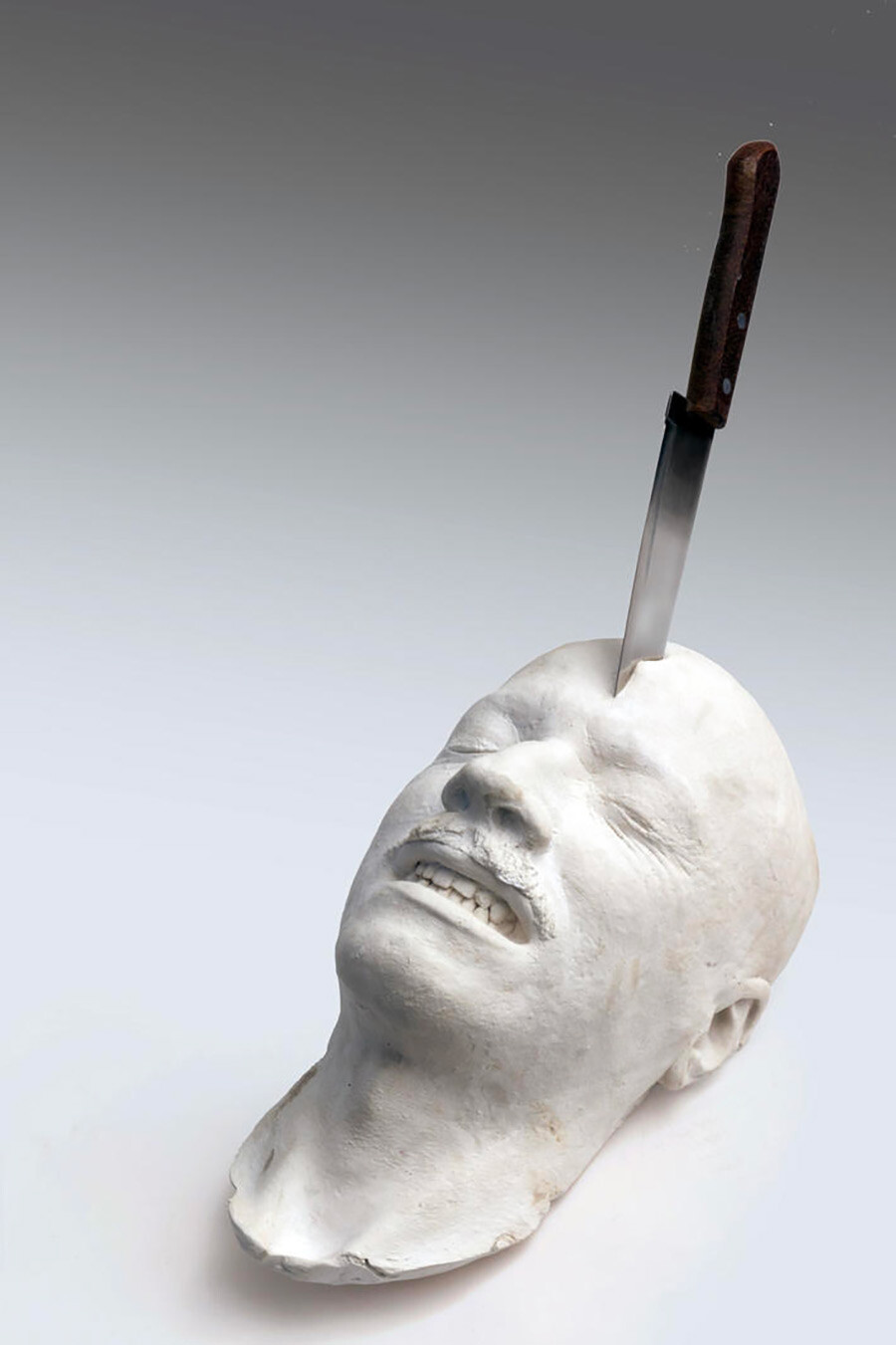 Mayana Nasybullova. Bad thoughts from the series «Viva la violence», 2020
Mayana Nasybullova. Bad thoughts from the series «Viva la violence», 2020
Later projects – the ironic series “Lenin for the Soul”, “The Motherland Listens” and others – were also devoted to memory and the comprehension of society. In her installations, Mayana combines sculptural forms with sound works and painting, which she executes just as well as spatial objects.
56. Irina Nakhova
 Irina Nakhova. Room No. 1, 1983
Irina Nakhova. Room No. 1, 1983
Having entered the conceptualist circle in the 1970s at a very young age, Nakhova quickly rose to prominent status. She was one of the first Russian artists to work in the total installation genre: her “Rooms” series of installations in her own apartment went down in history.
 Irina Nakhova. From the Partial Triumph I project, 1989
Irina Nakhova. From the Partial Triumph I project, 1989
Since then, her art has always been imbued with personal history, and architecture has formed an important component of her practice. She represented Russia at the Venice Biennale in 2015.
READ MORE: Irina Nakhova: The necessity for conceptualism may be returning today
57. Boris Orlov
 Boris Orlov. Imperial Bust (Sailor), 1975
Boris Orlov. Imperial Bust (Sailor), 1975
Orlov represents the Sots Art movement in sculpture. The artist became famous for his busts, in which antique sculptural portraits acquire modern features through Soviet heraldry.
 Boris Orlov. Bust of the Empress, 1988
Boris Orlov. Bust of the Empress, 1988
Orlov’s main themes are power, imperial thinking and its origins. In doing so, the artist explores the “grand imperial style”, finding parallels in the aesthetics and ideology of different empires: from antiquity to the Soviet Union. After the collapse of the USSR, Orlov turned to the “end of history” theme, reconstructing the myth of a vanished civilization.
58. Anatoly Osmolovsky
 Anatoly Osmolovsky. A Voyage to Brobdingnag Land (Mayakovsky/Osmolovsky). 1993/2002. Documentation of performance. Photo: Igor Mukhin
Anatoly Osmolovsky. A Voyage to Brobdingnag Land (Mayakovsky/Osmolovsky). 1993/2002. Documentation of performance. Photo: Igor Mukhin
Artist and art theorist, co-founder of the “Expropriation of the Territory of Art” movement, Osmolovsky in the 1990s was an active representative of Moscow Actionism. He and his comrades-in-paint formed the Russian swearword khuy with their bodies on Red Square (“a challenge to the state of affairs in the Soviet economy and politics”), built a barricade of boxes in downtown Moscow, and smoked a cigar on the shoulder of the monument to poet Vladimir Mayakovsky.
 Anatoly Osmolovsky. Golden Fruit of Nathalie Sarraute, 2006
Anatoly Osmolovsky. Golden Fruit of Nathalie Sarraute, 2006
Come the 21st century, his focus switched to creating art objects and sculptures, and since 2011 he has been occupied with the Baza Institute of Contemporary Art, which he founded for artists and art critics.
59. Gosha Ostretsov
 Gosha Ostretsov. Connoisseurs of beauty, 2014
Gosha Ostretsov. Connoisseurs of beauty, 2014
Ostretsov started as a fashion designer, adhering to the aesthetics of the Russian avant-garde. Living in Paris, he worked as an assistant to designers Jean-Charles de Castelbajac and Jean-Paul Gaultier. There he pursued his own artistic creativity. Ostretsov creates a series of paintings and sculptures based on comic-book aesthetics.
 Gosha Ostretsov. Policeman the liar, 2013
Gosha Ostretsov. Policeman the liar, 2013
They are devoted to alternative, in essence anti-utopian models of society, whose characters and structures are freed from the established framework, creating a new mythology. His oeuvre was on display in the Russian pavilion at the 53rd Venice Biennale.
60. Pavel Otdelnov
 Pavel Otdelnov. «56.2354828/43.5809789», 2016
Pavel Otdelnov. «56.2354828/43.5809789», 2016
A subtle painter known for his themed projects exploring the imperceptible pain points of the surrounding reality in the present and recent past. One of his key series is “Industrial Zone”, based on the story of the artist’s own family, three generations of which worked at a chemical plant in the city of Dzerzhinsk and lived through the industrialization of the 1930s, the production of chemical weapons during WWII and the decline of large-scale production in the 1990s.
 Pavel Otdelnov. Stonehenge, 2013
Pavel Otdelnov. Stonehenge, 2013
Moving from the particular to the general, shifting the optics, the artist tells the tragic stories of both specific individuals and Russia herself.
61. Timofey Parshchikov
 Timofey Parschikov. Burning News, 2009
Timofey Parschikov. Burning News, 2009
Parshchikov, the author of various photo series shot both in Russia and abroad, strives for the spectacular, cinematic image. For example, his renowned "Suspense" series is united by the theme of disturbing uncertainty, which, in theory, the atmosphere of large cities lacks. The perspectives and entourage are found in city life itself, generally peeping out in the evening.
 Timofey Parschikov. Napoli, 2008. 2006–2014
Timofey Parschikov. Napoli, 2008. 2006–2014
The staged series "Burning News" addresses the aggressive nature of news: flaming newspapers scorch the hands of readers holding them. For Parshchikov, any photograph seeks to highlight non-obvious newsworthy events that get overlooked in the flow of life. His solo exhibitions have been held in Russia, France, Germany, Italy and elsewhere.
62. Pavel Pepperstein
 Pavel Pepperstein. Black Square and Campbell, 2008
Pavel Pepperstein. Black Square and Campbell, 2008
Pepperstein is in demand not only as an artist, but also as a writer. In many ways, these two areas overlap: Pepperstein’s literature is visual, and his graphic work is literary. And both are united by absurdist, psychedelic motifs. He inherited a taste for the absurd from the OBERIU movement (an avant-garde collective of Russian Futurist writers, musicians and artists in the 1920s and 30s).
 Pavel Pepperstein. Oh God! They Sent a Man With a Hangover Again! 2009
Pavel Pepperstein. Oh God! They Sent a Man With a Hangover Again! 2009
That said, his literary and artistic fantasies are not abstract, for his art is non-trivial and socio-political, reflecting, inter alia, on the fate of Russia, her past and future.
63. Tanya Pioniker
 Tanya Pioniker. St.We, 2010
Tanya Pioniker. St.We, 2010
This young artist uses traditional graphic techniques (watercolor, ink, etching) to create her own worlds on the borderline of fiction and reality, populating them with make-believe characters. The subtle craftsmanship and aspect are a nod to the famous works of Hieronymus Bosch.
 Tanya Pioniker. This is my style and it is not forbidden here, 2017
Tanya Pioniker. This is my style and it is not forbidden here, 2017
Her “Seven” (with its modern interpretation of the deadly sins), “Ouroboros” and other series resemble medieval bestiaries, but based on personal experiences. The optics reveal global timeless layers in contemporary subjects.
64. Viktor Pivovarov
 Viktor Pivovarov. Reflections, 1965–1966
Viktor Pivovarov. Reflections, 1965–1966
In the 1970s and 80s, Pivovarov belonged to the circle of Moscow Conceptualists. An outstanding illustrator of children’s literature, in his “art for adults” he prefers the language of graphics. Unlike Ilya Kabakov, however, who explored the foundations of the collective Soviet myth, Pivovarov initially focused on the inner world of humankind.
 Viktor Pivovarov. Moscow Party, 1971
Viktor Pivovarov. Moscow Party, 1971
His works are more sensuous, emotional and intimate, peopled with characters who try to shape this comfortless world into their own personal surrealistic space.
65. Sasha Pirogova
Born in 1986, the artist bases her staged videos on the movements of performers and elements of modern dance, finding a plastic and poetic form for reflecting on subjects from everyday life and on the “eternal themes” of art such as love and the seasons.
Her carefully choreographed, spectacular compositions spotlight the energy of the bodily interaction between the performers. The works resemble living sculptures, energizing the screen through dance and evoking in the viewer a sense of the unpredictable fluidity, complexity and uncontrollability of bodily being. Her work "Garden" was exhibited in the Russian pavilion at the 57th Venice Biennale.
66. Ivan Plyusch
 Ivan Plyusch. Episode 1. From the Till the Roosters Sang series. 2011
Ivan Plyusch. Episode 1. From the Till the Roosters Sang series. 2011
A monument sculptor by training, the artist gravitates toward large-scale works, only not using “eternal” materials, but temporary, sometimes ephemeral ones. He is a master of spatial installations, yet painting remains a core part of his work.
 Plusch’s Theatre exhibition in Moscow Museum of Modern Art (MMOMA)
Plusch’s Theatre exhibition in Moscow Museum of Modern Art (MMOMA)
Of late, Plyusch has been evolving toward post-scientific methods, creating works with the aid of artificial intelligence. He is one of the founders of the St Petersburg art studio Unconquered.
67. Alexander Ponomarev
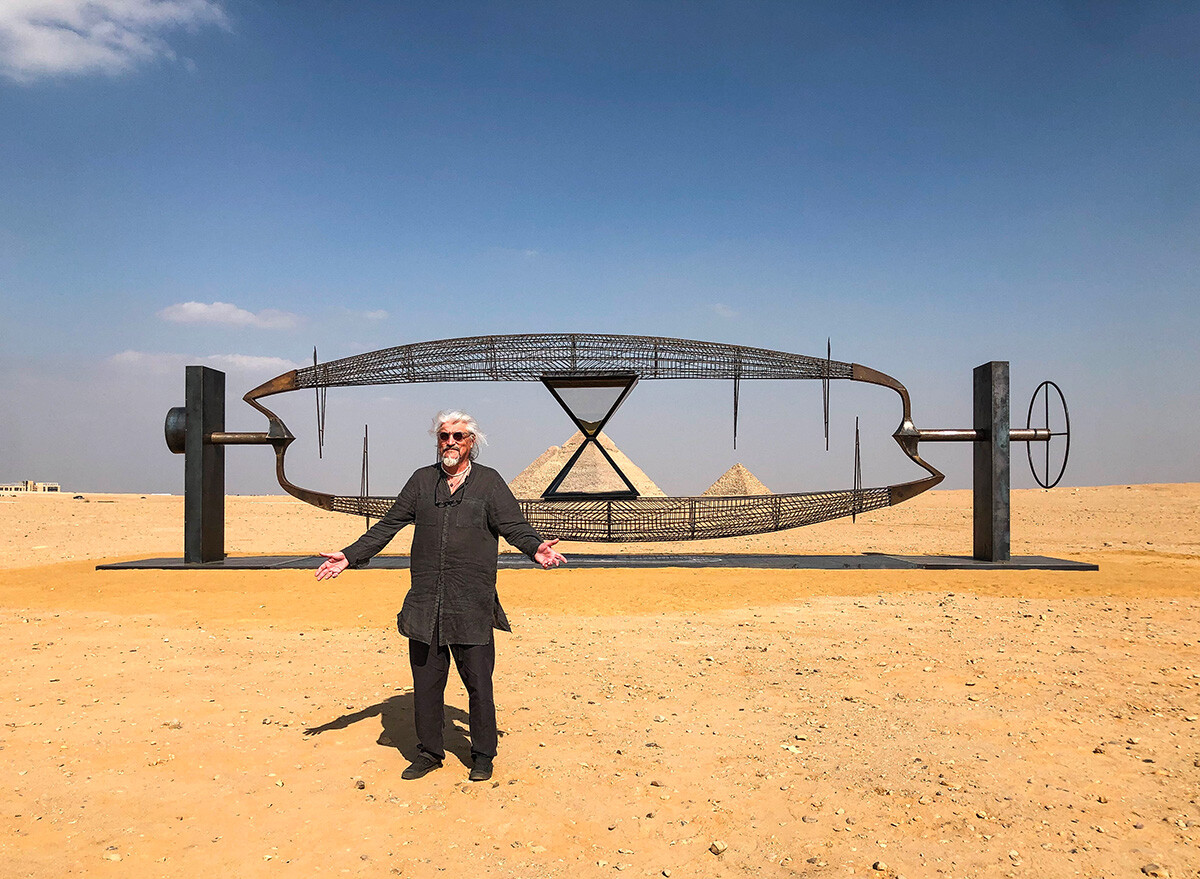 Alexander Ponomarev and his ‘Ouroboros’ installation in Egypt, 2021
Alexander Ponomarev and his ‘Ouroboros’ installation in Egypt, 2021
Ships, submarines and the romance of the Russian Far North are the primary associations with his art. Ponomarev graduated in the 1970s from art school and the Higher Engineering Marine School in Odessa, served seven years in the Soviet navy, and has since built a creative career on this foundation.
 Alexander Ponomarev. Windtruvian Man, 2015
Alexander Ponomarev. Windtruvian Man, 2015
During these past four decades, he has painted a combat submarine in bright colors, staged performances and art events in the Arctic, Greenland and Antarctica, navigated the Grand Canal in Venice in a makeshift submarine, and organized the Antarctic Biennale of Contemporary Art, in which hundreds of artists, philosophers and scientists spent 12 days sailing through the ice aboard a research vessel, holding debates and staging performances and poetry/philosophy readings.
68. Nikolay Polissky
 Nikolay Polissky. Snowmen, 2000
Nikolay Polissky. Snowmen, 2000
The main figure in Russian land art, and the creator and ideologist of the Nikola-Lenivets Art Park in the Kaluga region and the Archstoyanie festival, which has been held there since 2006. The first intrusion of his art into the rural landscape came in the form of an army of 200 snowmen made by local residents on the banks of the Ugra River, where in the 15th century it is said that hostilities broke out between Russian and Tatar troops.
Subsequently, Polissky teamed up with local crafters to create a workshop that specializes, under his leadership, in vine-weaving, wood-carving and making large-scale art objects from other environmentally friendly materials, figuratively referring to classical triumphal arches, the Large Hadron Collider, artificial intelligence and even the outer pipes on the building of the Centre Pompidou in Paris. Together with his master crafters, he creates various art objects around the world.
69. Alexander Povzner
 Alexander Povzner. Traces, 2009
Alexander Povzner. Traces, 2009
This artist and sculptor organically combines an interest in traditional techniques and figurative forms with the ideas of conceptualism. Most of his work is built on self-reflection: a careful examination of childhood impressions, fantasies, academic learning and routine, all multiplied by humor and self-irony.
 Alexander Povzner. Miss Mira, 2013
Alexander Povzner. Miss Mira, 2013
“My works are not illustrative, but my experiences — especially ones that are incomprehensible to me — comes out in images in some strange way. Just like psychoanalysis,” says the artist.
70. Vitaly Pushnitsky
 Vitaly Pushnitsky. Tokyo. Moth Flight Observation. 2019
Vitaly Pushnitsky. Tokyo. Moth Flight Observation. 2019
“A picture is a sign, an image, it doesn’t need a text or even a viewer, it’s a memory that perhaps no one even remembers, a thought that’s precipitated into material sediment,” this St Petersburg artist believes. He works with objects, installations, sculpture and graphics, but singles out painting as the most "honest" technique.
 Vitaly Pushnitsky. Studio. Waiting #16. 2018
Vitaly Pushnitsky. Studio. Waiting #16. 2018
His works, regardless of subject matter, are characterized by a certain detachment, contemplation and melancholy. Whether it’s classical ruins, an artist’s studio or landscapes, they are executed with great care and often speak of loneliness and the ravages of time.
71. Timofey Radya
 Timofey Radya. What are we? Where do we come from? Where are we going? 2017
Timofey Radya. What are we? Where do we come from? Where are we going? 2017
One of the most famous street artists in Russia. Radya started in the mid-2000s by creating graffiti and art objects in his native Yekaterinburg. His geographical scope later expanded to include Moscow, St Petersburg, Berlin, New York and other cities.
 Timofey Radya. Idle Talk, 2016
Timofey Radya. Idle Talk, 2016
His works tend to be made for a particular place with a social or political message. However, with his educational background in philosophy, he does not employ slogans, rather a meditative approach to the issues raised.
72. The Recycle group
 Recycle Group. New Nature, 2021
Recycle Group. New Nature, 2021
Garbage cans with human silhouettes protruding from walls, reminiscent of ancient steles and tombstones; antique-like reliefs but made of mesh; allusions to the portals of medieval cathedrals made of corrugated pipes; a “cultural layer” in which cell phones permanently embedded; a huge Facebook “F” made of polyurethane; virtual reality.
 Recycle group. ‘Сonversion’, 2015
Recycle group. ‘Сonversion’, 2015
The timeless and the trashy, the traditional and the hi-tech, sit side by side in the work of duo Andrey Blokhin and Georgy Kuznetsov, active since the mid-2000s. Their eye-catching art objects and installations have already taken the artists halfway around the world, from Moscow to London to New York.
73. Anna Rotaenko
 Anna Rotaenko. The Network
Anna Rotaenko. The Network
The arsenal of themes and media (from electronic music and gaming technologies to installations) of this young artist is extensive. “Feminism, the urban environment and temporary urban materials, relationships within communities, mass culture and digitalization, critical engineering and more” are just a handful of her interests.
 Ringtone
Ringtone
Some of her most striking projects are “Ringtone” (a “belfry” made of pipes and cross-shaped supports that emitted militarized sounds) and “The Network” (a giant, pink bouncy-castle cage).
74. Roman Sakin
 Roman Sakin. Curaspatia, 2020
Roman Sakin. Curaspatia, 2020
Sakin creates alternative realities very similar to our own, which seem to comment on it with a hint of absurdity. His “Curaspatia” (Latin: cura “cure”, spatio “space”) is a "philosophical and therapeutic system", a kind of healthy lifestyle project with absurdist guidelines.
 Roman Sakin. From 'Controllable Sculptures' series
Roman Sakin. From 'Controllable Sculptures' series
And then there were the minimalist “Controllable Sculptures”, consisting of mobile parts that the artist moved around manually. For example, “Signal Tower”, which stood in the courtyard of Moscow’s Tretyakov Gallery, was considered a “democracy simulator” in that viewers themselves determined how the object appeared.
75. Aidan Salakhova
 Aidan Salakhova. Without words №1, 2014
Aidan Salakhova. Without words №1, 2014
The daughter of the famous Soviet artist, Tair Salakhov, she is a master with marble (she has her own studio in Carrara, Italy), as well as with painting and graphics. The semantics of her work is based on images of the East filtered through the prism of European culture, deliberate eroticism and subtle sensuality.
 Aidan Salakhova. Hermaphrodite, 1997
Aidan Salakhova. Hermaphrodite, 1997
In the 1990s, Aidan opened one of the first commercial modern art galleries in post-Soviet Russia. The gallery officially closed in 2012, whereafter the artist focused on her own work.
76. Igor Samolet
 Igor Samolet. From the project «I woke up already tired» (triptych), 2020
Igor Samolet. From the project «I woke up already tired» (triptych), 2020
The main theme of his work is modern communication via smartphone and the impact of digital on everyday life. Most of his works make use of iPhone screenshots. Presented in the form of huge prints, collages and sculptures, they transform the private into the public, creating a sense of involvement in others’ lives and, conversely, in one’s own life through digital technologies.
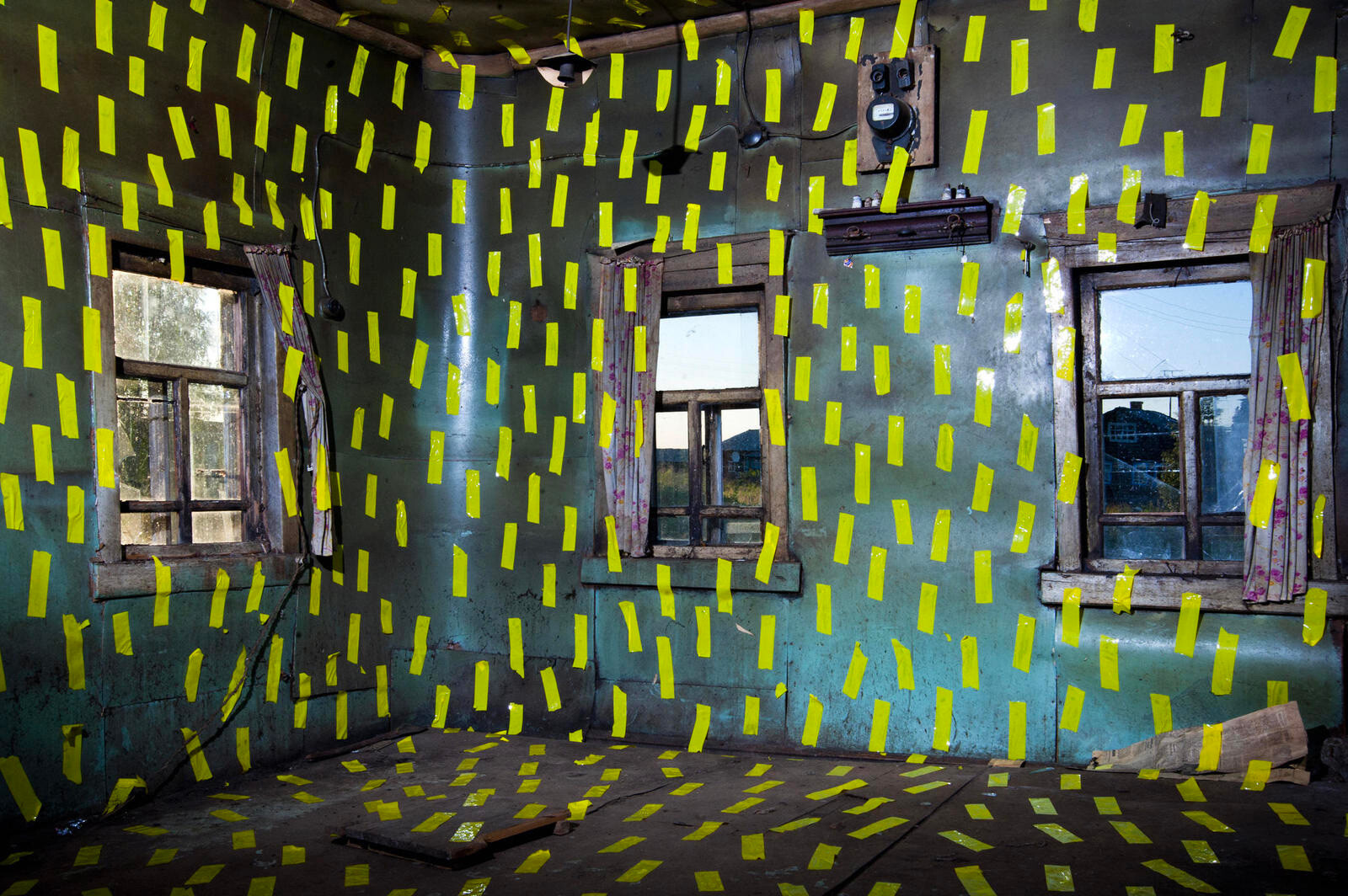 Igor Samolet. House for firewood from the project «Herbarium», 2014
Igor Samolet. House for firewood from the project «Herbarium», 2014
By adding everyday objects to the screenshots, he arranges the space of his exhibitions in the manner of Disneyland, in which the viewer forgets their worries and enjoys the fabulous setting.
77. Maria Safronova
 Maria Safronova. Outpost, 2017
Maria Safronova. Outpost, 2017
This artist’s preferred techniques seem very traditional: figurative painting and graphics. But underneath the realistic scenes, most often snatched from everyday life (school, hospital, office), lies an exposure of the absurd and social criticism.
 Maria Safronova. Elevator, 2017
Maria Safronova. Elevator, 2017
Sometimes her analysis of the “human biosystem” leads the artist to visions that verge on the surreal. Safronova often includes 3D models or specially chosen items in her exhibitions.
78. The Sever-7 Group
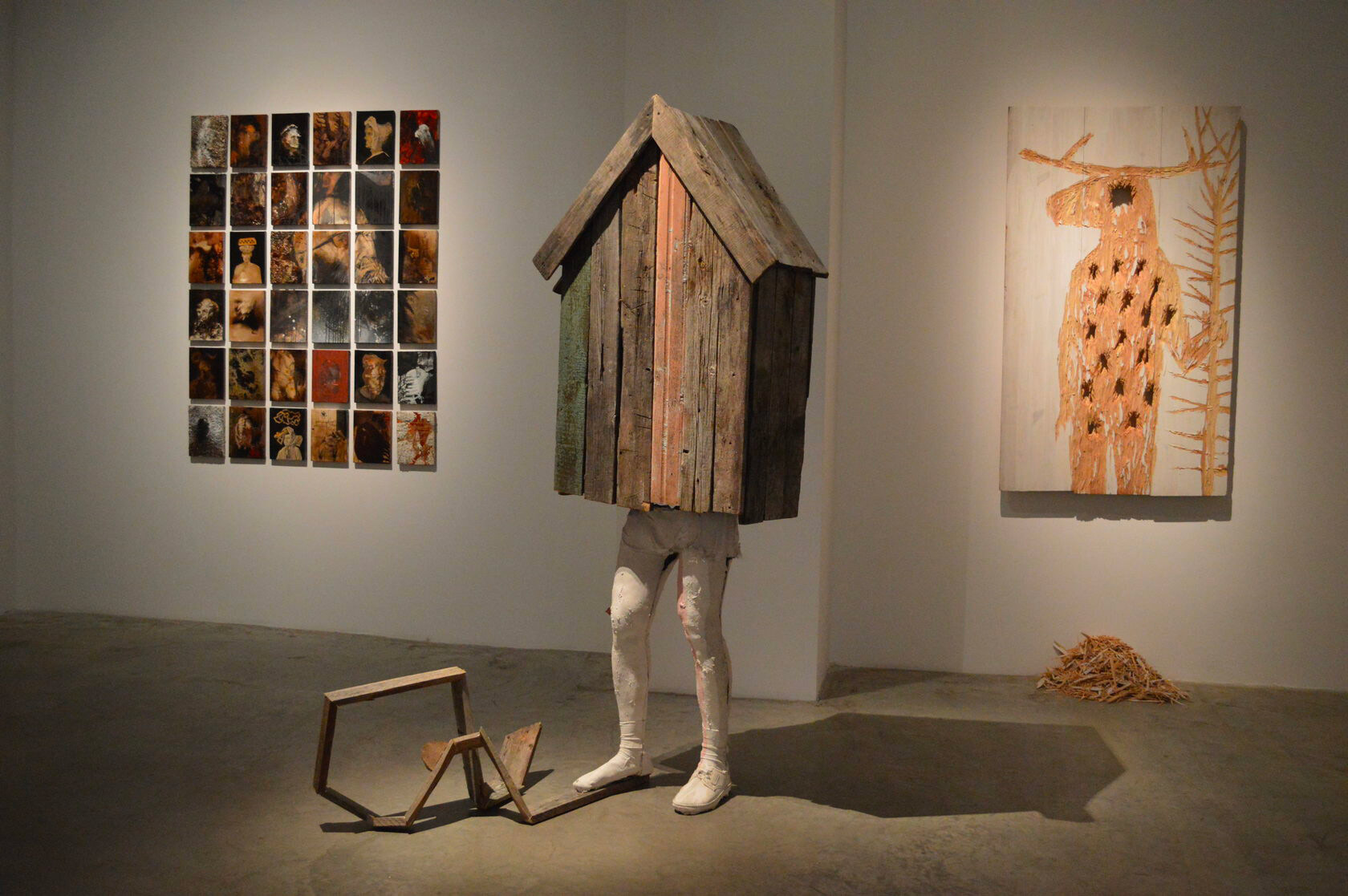 North-7 School of Active Drawing and Performative Posing exhibition, 2017
North-7 School of Active Drawing and Performative Posing exhibition, 2017
Sever-7 (North-7), which emerged in St. Petersburg in 2013, is one of the most energetic art collectives on the current scene. The focus of the group (which has a fluid lineup, made up of nine permanent members plus “friends”) is on interaction, process, performativity and fighting established norms on all fronts.
 Lost & Found North-7 Expedition, exhibition at M HKA. Antwerp, Belgium, 2019
Lost & Found North-7 Expedition, exhibition at M HKA. Antwerp, Belgium, 2019
They organized the “Saint Dogvilleburg” independent contemporary art fair with a “self-proclaimed city of artists”, opened the School of Active Drawing and Performative Posing and have held numerous exhibitions, including at the M HKA Museum in Antwerp.
79. Igor Shelkovsky
 Igor Shelkovsky. Reliefs, 2019
Igor Shelkovsky. Reliefs, 2019
A sculptor from the legendary group of nonconformists: those who worked in opposition to the socialist realism imposed in Soviet times. Developing from the early 1970s onwards, his sculpture style seeks to reduce the image to a scheme, a formula, a sign.
 Igor Shelkovsky. Man running, 2019
Igor Shelkovsky. Man running, 2019
He is interested in landscapes and urban space, which he deconstructs and on which basis he creates his own forms: a cloud as a set of wooden blocks in all shades of blue, a tree as a linear structure enclosed in a cage with urban silhouettes. In 1976 Shelkovsky emigrated to France, where in 1979-86 he published the magazine A-Ya, which introduced Soviet underground art to the West.
80. Sergey Shekhovtsov
 Sergey Shekhovtsov. No. 1 From the Series "Motorcycles". 2002
Sergey Shekhovtsov. No. 1 From the Series "Motorcycles". 2002
A painter by training, Shekhovtsov graduated from the Surikov Moscow Academic Institute of Arts, but moved from pure painting to creating sculptural objects. His choice of materials – polystyrene, foam rubber, adhesive tape, spray paint – played an important role in his change of métier.
 Sergey Shekhovtsov. Boy and pigeons, 2004
Sergey Shekhovtsov. Boy and pigeons, 2004
Sergey developed his own plastic techniques, spectacular and instantly recognizable. At one point, his name was always mentioned in conjunction with the nickname "foam rubber", but later other materials came into play.
81. Sergey Shutov
 Sergey Shutov. Sea ( Self-portrait), 1983
Sergey Shutov. Sea ( Self-portrait), 1983
Back when the concept of “media artist” was still unknown in the USSR, Shutov was already experimenting with different contemporary art formats. As a prominent member of the underground scene, he worked on the cult film Assa (1987), which became the cinematic manifesto of perestroika.
 Sergey Shutov. Sun, 2017
Sergey Shutov. Sun, 2017
In 1992, Shutov created the first multimedia installation in Russia under the title “Sensual Experiences”. His later work was characterized by experimentation in the "borderlands" between painting, performance, video and sound art, and other media.
82. Sveta Shuvaeva
 Sveta Shuvaeva. From the series «Crowd characters», 2015
Sveta Shuvaeva. From the series «Crowd characters», 2015
Shuvaeva is considered part of the so-called “Samara Wave”, having lived in the city from 2003 to 2010, where she studied environmental design at the architectural institute and played an active role in the young artistic scene. Her specialization provided the impetus for all future projects: graphics, collages, installations, fashion design.
 Svetlana Shuvaeva with her installation 'Lakeview special offer .. '
Svetlana Shuvaeva with her installation 'Lakeview special offer .. '
In 2015, she became one of the stars of the 3rd Industrial Biennale in Yekaterinburg with her “Crowd Character” series, a semi-abstract homage to Kazimir Malevich, featuring faceless people in a metaphysical space. Since then, she has worked on multiple projects in museums in Russia and Europe.
83. Slava PTRK (Stanislav Komissarov)
 Slava Ptrk. Great laundry from the series «Loneliness», 2016
Slava Ptrk. Great laundry from the series «Loneliness», 2016
One of Russia’s most notable young street artists, besides ironic graffiti, he explores socio-political themes. Be it the Chechen wars, as conceptualized in the joint project “1999” with the indie band SBPC, based on the memories of participants and eyewitnesses, or general nationwide apathy in the performance Pokhuy plyaschem (“F*** it, let’s dance”).
In the latter, 50 couples waltzing in the snow do not want to hear bad news, and when a drone flies overhead, it becomes clear that the title is a reference to them.
84. Haim Sokol
 Haim Sokol. Untitled (stairs), 2009
Haim Sokol. Untitled (stairs), 2009
“My task and main challenge is to find and show traces of the past in the present, but not for nostalgic gratification, but so that the lost trace resonates with the present,” says artist, researcher and poet Haim Sokol. History (mainly of his own family) and traumatic experience have been main themes in his work since his first exhibition “Cryptomnesia” in 2007.
 Haim Sokol. Testimony
Haim Sokol. Testimony
Since then, his emblematic black birds and human figures have featured a diverse range of projects, including solo exhibitions at the Moscow Museum of Modern Art and the Tretyakov Gallery.
85. Alexandra Sukhareva
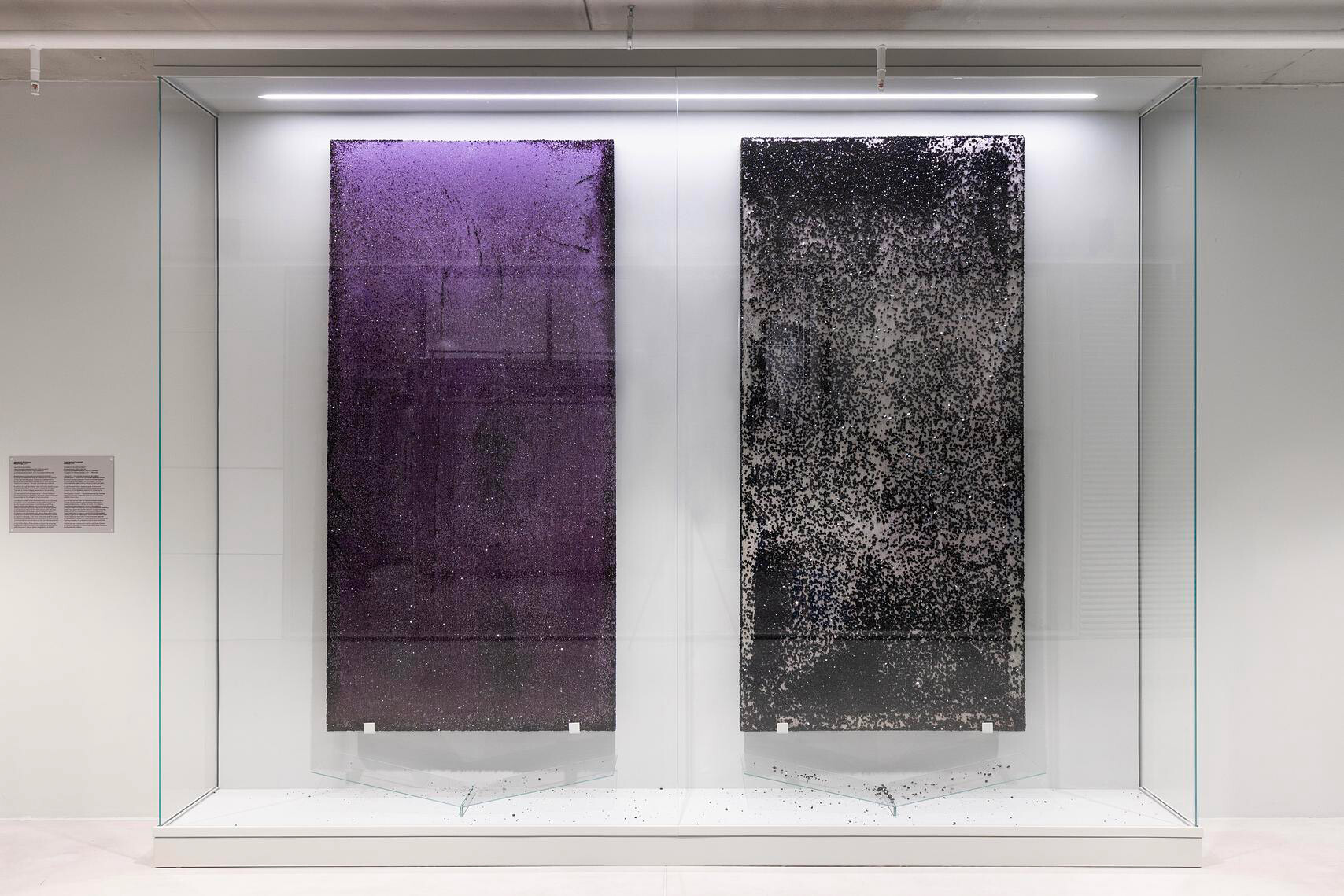 Alexandra Sukhareva. Beginnings, 2021
Alexandra Sukhareva. Beginnings, 2021
Sukhareva is the creator of numerous installations and art objects in which time and nature are effectively co-authors. She makes use of the chemical properties of materials as metaphors for her thoughts, experiences and memories, be it the growth of crystals or the oxidation of mirror surfaces.
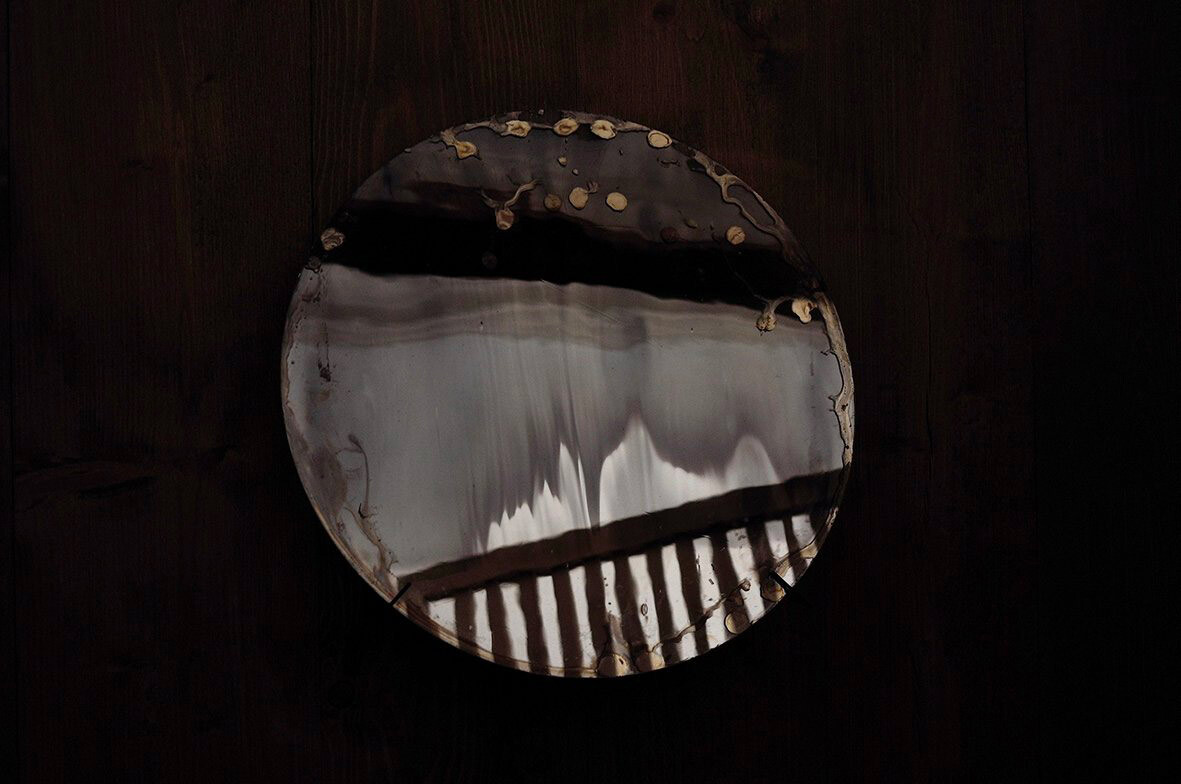 Alexandra Sukhareva. Goodbye, Gaze, 2015
Alexandra Sukhareva. Goodbye, Gaze, 2015
Sukhareva is one of the most in-demand Russian artists in Europe today: since 2012, her work has been promoted by the V-A-C Foundation of Leonid Michelson and Teresa Mavica. Thanks to them, her work appeared at the prestigious dOCUMENTA (13) contemporary art exhibition in Kassel, at the foundation’s space in Venice, Tate Modern gallery in London and other venues.
86. Leonid Tishkov
 Leonid Tishkov. Look at Your House
Leonid Tishkov. Look at Your House
His fantastical subjects exist in various art forms, from graphics to video installations to livres d’art. He began in the late 1970s, when as a medical student he became dabbled in the art of caricature. Later he made the acquaintance of the Moscow Conceptualists and swapped medicine for creativity.
 Leonid Tishkov. The receding road leads to yourself, 2004
Leonid Tishkov. The receding road leads to yourself, 2004
According to Tishkov, he has a “mythological mindset” that intertwines Ural folklore, old wives’ tales, metaphysics, French surrealist poetry and Velimir Khlebnikov’s zaum (“beyond mind”) linguistic experiment. From this mixture emerges a personal mythology with improbable storylines branching out.
87. Olga Tobreluts
 Olga Tobreluts. "DOLLAR" from her "New Mythology" series
Olga Tobreluts. "DOLLAR" from her "New Mythology" series
Tobreluts crystallized as an artist in the late 1980s, studied architecture in Leningrad (now St. Petersburg) and computer graphics at the Berlin ART+COM Institute, and was a member of the legendary New Academy group under the intellectual guidance of Timur Novikov. Neoacademism – with its cult of the human body, classical canons of beauty and numerous references to art history – unites in her work with modern computer technology.
 Olga Tobreluts. Apollo and Hyacinth, 2005
Olga Tobreluts. Apollo and Hyacinth, 2005
Lenticular panels, videos and pictorial art become a means for creating one’s own metaverse, where modern pop idols, ancient heroes, advertising and fashion brands cross paths.
88. Natalia Turnova
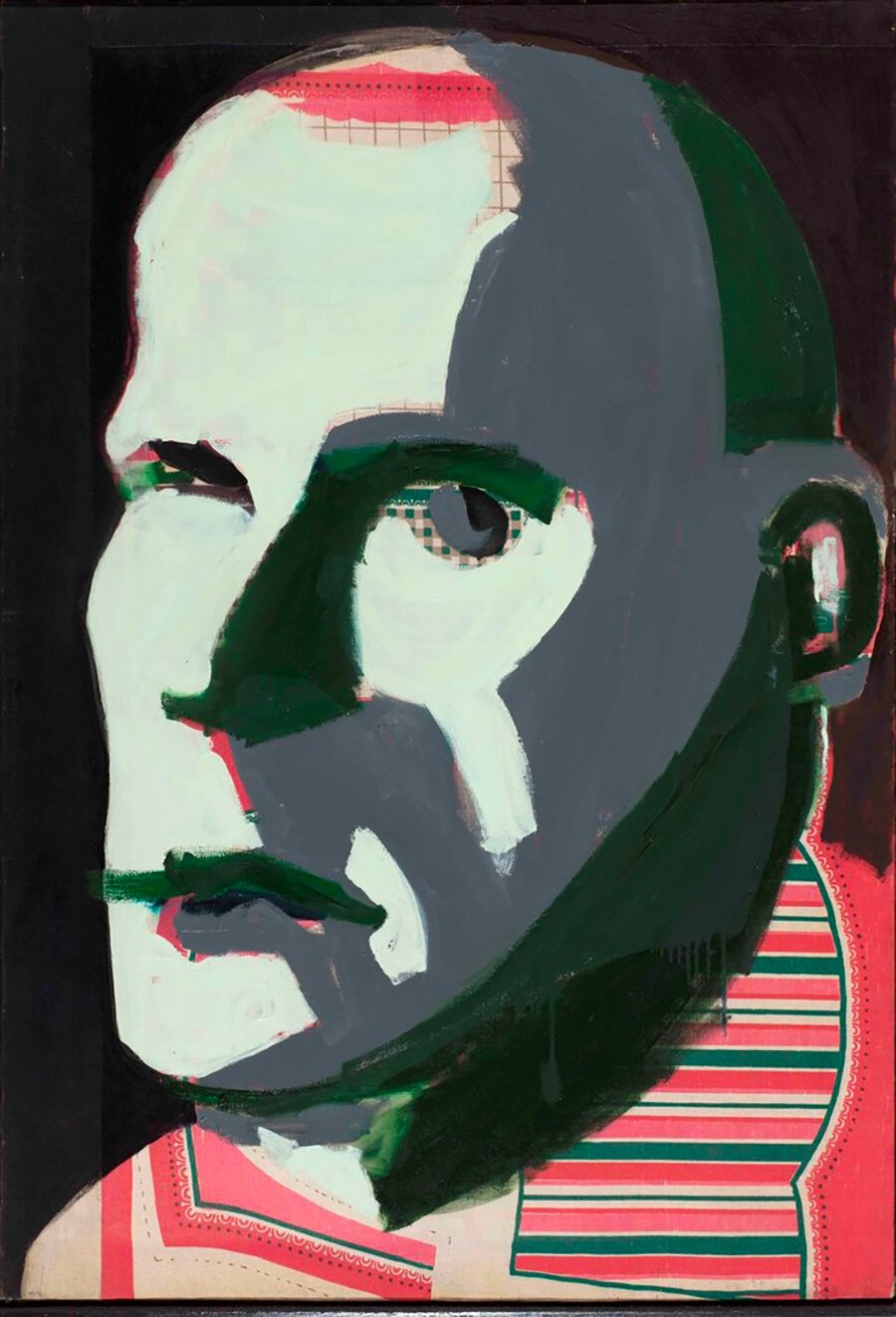 Nataliya Turnova. Mayakovsky, 1990
Nataliya Turnova. Mayakovsky, 1990
The source of her painting is Fauvism. But only the source, not the result. Turnova is an independent, free-thinking artist who discards stereotypes. Her long fascination with the portrait genre led her to create her own style, where color and form act as both psychological characteristics and existential analytical tools.
 Nataliya Turnova. From the series "Love", 2002
Nataliya Turnova. From the series "Love", 2002
From her painting, she has derived art objects, sculptures and installations. For her, the question of “what is done” is of less interest than “how”.
89. Ivan Tuzov
 Ivan Tuzov. Collection, 2013
Ivan Tuzov. Collection, 2013
Pixel art is this artist’s calling card. In the digital age, creating pixelated pictures either drawn or as a mosaic is not even glitch art, but a move away, toward the universal.
 Ivan Tuzov. Untitled, 2019
Ivan Tuzov. Untitled, 2019
In this way, Tuzov turns the leader of the world proletariat or policemen into almost cartoon characters, heroes of some kooky epic. With brush in hand once more, the artist’s experiments with abstraction are gaining popularity.
90. Dmitry Venkov
A video artist who operates at the intersection of auteur cinema and video art. His films explore different social groups and communities. For instance, Krisis (2016) covered the dispute on Facebook over the demolition of the Lenin monument in Kiev. His most successful film to date is Hymns of Muscovy (2018), a plotless, visually impeccable journey through three architectural styles of Moscow: Stalinist Empire, Soviet Modernism and modern architecture.
The inverted camera slowly drifts along the iconic buildings, turning the people-free city into a phantom in the clear azure sky. The film picked up awards at the Oberhausen, Melbourne, Vancouver and other festivals. Venkov’s work was featured in documenta 14, a solo exhibition held in 2020 at the Museum of Contemporary Art in Antwerp (M HKA).
91. Alexander Vinogradov
 Alexander Vinogradov, Vladimir Dubossarsky. The Kiss. 2003
Alexander Vinogradov, Vladimir Dubossarsky. The Kiss. 2003
From 1994 to 2014, Vinogradov worked in tandem with Vladimir Dubosarsky, whose joint projects brought world fame and commercial success. Stylistically, their painting mixed the techniques of social realism and pop art, while the themes captured the mood swings of the post-Soviet decades, with all the attributes of the transition to capitalism.
 Alexander Vinogradov. Crossroad from the PARADISO IDEALE, 2017 series
Alexander Vinogradov. Crossroad from the PARADISO IDEALE, 2017 series
In his solo work, Vinogradov departs from this style to the max. A subtle draftsman and observer-philosopher, he paints landscapes and urban views reflected in shop windows and train windows.
92. The “What Is To Be Done” Group
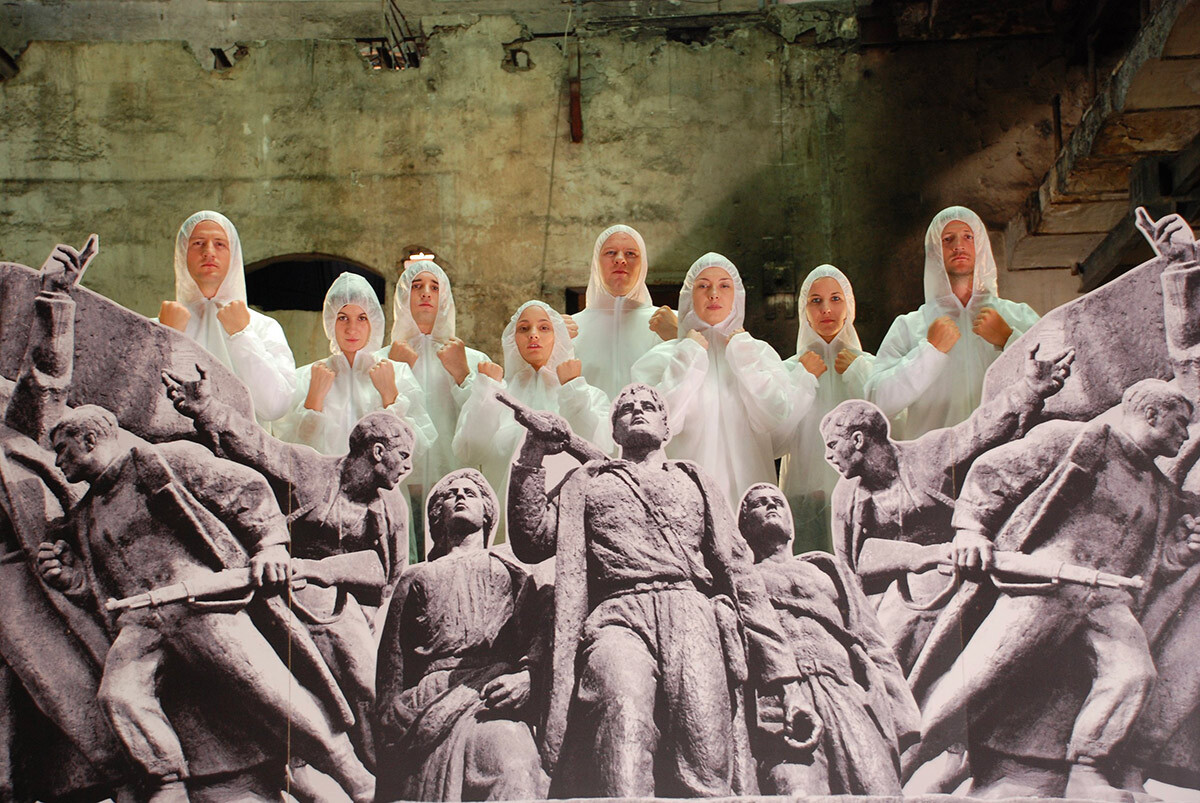 “What Is To Be Done” [Chto delat]. Partisan Songspiel, A Belgrade Story, 2009
“What Is To Be Done” [Chto delat]. Partisan Songspiel, A Belgrade Story, 2009
The group’s name is a riff on the novel by 19th-century philosopher Nikolay Chernyshevsky (Chto Delat?) and the later political pamphlet by Lenin. The group is made up of artists, critics, philosophers and writers from St Petersburg, Moscow and Nizhny Novgorod. Their output includes art exhibitions (installations or projects in public spaces), publishing newspapers, staging plays and performances, as well as educational, activist and curatorial activities.
 Chto Delat? Study,Study and act again, 2014
Chto Delat? Study,Study and act again, 2014
As per the name, the group’s position is critical of modern capitalism and the social order it creates, and strives for the liberation of creative activity and art from the system of consumer and entertainment production. The group's work is featured in many museums, including the MoMA in New York and the Centre Pompidou in Paris.
93. Ustina Yakovleva
 Ustina Yakovleva. Untitled, 2019
Ustina Yakovleva. Untitled, 2019
Yakovleva began with abstract painting, where the image, painted in small strokes in the manner of Aboriginal Australians, seems to grow out like a living organism, filling the entire canvas or individual sections.
 Ustina Yakovleva. From the series "Circles" (IV), 2019
Ustina Yakovleva. From the series "Circles" (IV), 2019
Later she switched from biomorphic forms to making art objects and sculptures from fabric that resemble mollusks deprived of their usual habitat. She uses rich embroidery, generously adorning her objects with beads and other decorative elements and patterns, as if competing with nature.
94. The Yelikuka Group
 Elikuka. The Power of Art, 2021
Elikuka. The Power of Art, 2021
The duo of Oleg Yeliseev (born 1985) and Yevgeny Kukoverov (born 1984). In addition to art objects made from everyday items, and interactive installations, the artists create music somewhere between new wave and punk, plus performance art and painting.
 EliKuka Group. “Revolt of the World Order Simulators”
EliKuka Group. “Revolt of the World Order Simulators”
Their work is imbued with a mischievous mood, an ironic attitude to the mundane, behind which there lurks criticism of the hierarchy of society and consumerism, as well as the desire to free the viewer from the pressures of the digital age.
95. Alisa Yoffe
 From 'Aperto Raum' exhibition curated by Alice Yoffe, 2019
From 'Aperto Raum' exhibition curated by Alice Yoffe, 2019
The author of large-format graphic and pictorial works that react to current social and political events. The style, executed in black and white, is close to expressionism.
 Alice Yoffe. Suprematic naked, 2019
Alice Yoffe. Suprematic naked, 2019
The artist creates her works spontaneously, drawing either directly on canvas or from digital sketches. They have caught the eye of fashion brands and resulted in collaborations with Comme des Garçons, Maison Margiela and appeared. Joffe has held solo exhibitions in Russia and Europe.
96. Vadim Zakharov
 Vadim Zakharov. Bauhaus Torah, 2002
Vadim Zakharov. Bauhaus Torah, 2002
Another of the 1980s new wave generation of Moscow Conceptualism. In his art, like many others, he combines textuality with elements of street art, gently mocking the 70s generation. After emigrating to Germany, Zakharov changed his humorous tone to something more romantic.
 Vadim Zakharov's Danaë installation at the Russian pavilion of the 55th Venice art biennale, 2013
Vadim Zakharov's Danaë installation at the Russian pavilion of the 55th Venice art biennale, 2013
His art is an endless reflection, a hypertext that interweaves personal memories, sensations and experiences of art and literature. He represented Russia at the Venice Biennale in 2013.
97. Anna Zhelud
 Anya Zhelud. House at the roadside, 2019
Anya Zhelud. House at the roadside, 2019
Whether she is bending sculptures from iron rods or painting everyday objects, the resulting contours are the essence of things, the “nerves” of feeling. Both her sculptures and paintings are highly graphic.
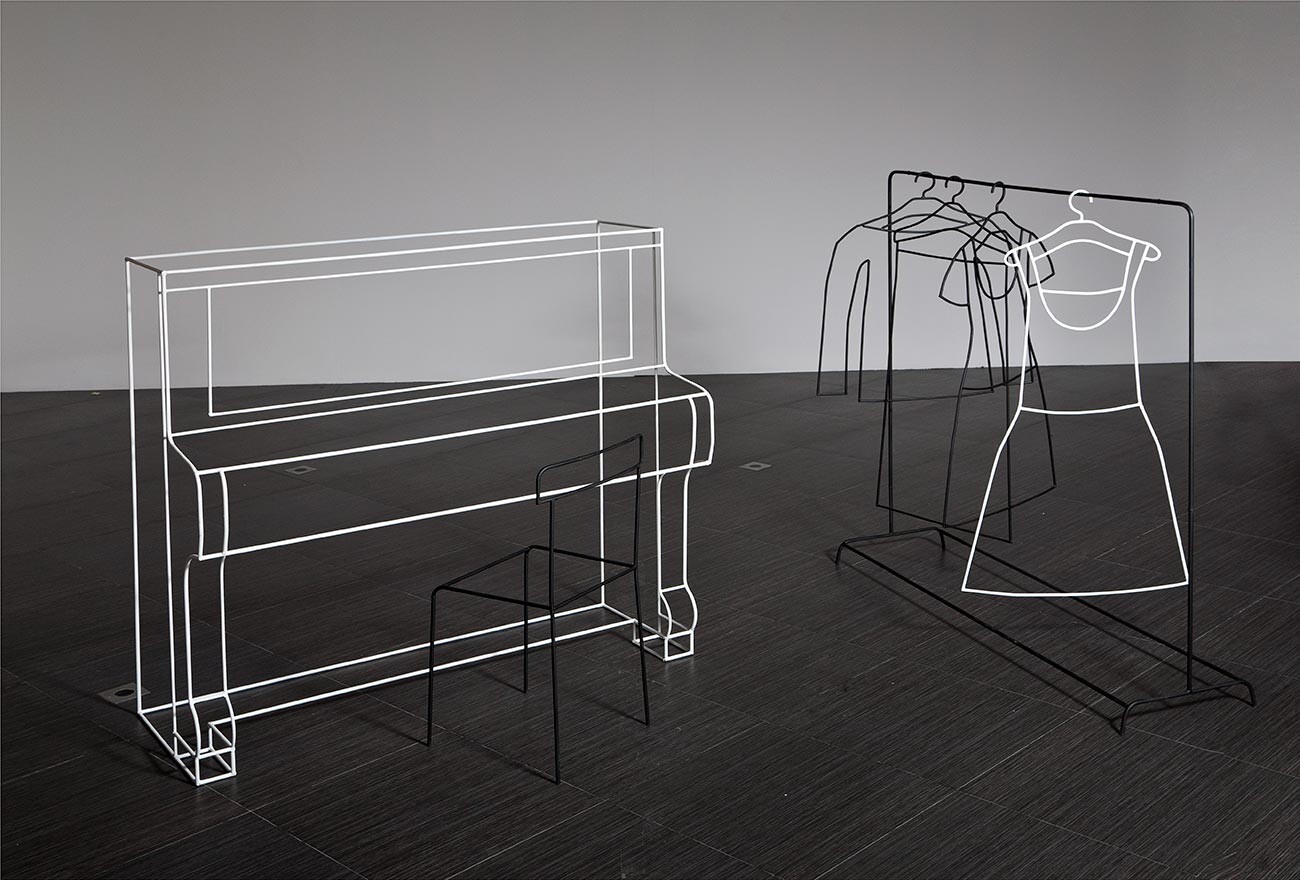 Anya Zhelud. Ladies’ Choice Dance. 2008
Anya Zhelud. Ladies’ Choice Dance. 2008
Zhelud is an artist of reflection, not commotion. And despite participation in the main program of the 53rd Venice Biennale in 2009, she went ahead with a giveaway exhibition of her works in Moscow in 2012 and opened a “non-gallery” space in the Moscow region, where commerce does not run the show.
98. Arseniy Zhilyaev
 Arseniy Zhilyaev. 'Museum of Proletarian Culture: The Industrialization of Bohemia' exhibition
Arseniy Zhilyaev. 'Museum of Proletarian Culture: The Industrialization of Bohemia' exhibition
With a degree in philosophy, this artist from Voronezh was first drawn to conceptualizing radical Marxism, and then Russian cosmism. Through the ideas of the latter, Zhilyaev came up with the concept of creating imaginary museums, freed from having to display canonical or generally recognized art.
 Arseniy Zhilyaev. A fragment from 'Tsiolkovsky. Second advent' installation
Arseniy Zhilyaev. A fragment from 'Tsiolkovsky. Second advent' installation
The “institutions” he created, in the form of total installations, captivated audiences in many real museums and galleries around the world, and his most memorable were shown at the Tretyakov Gallery in Moscow and at the Palazzo Tre Oci in Venice as part of the 2015 Biennale.
99. The ZIP group
 Bank-Shed. Beyond the center, Novo-Molokovo, Russia, 2019
Bank-Shed. Beyond the center, Novo-Molokovo, Russia, 2019
Having formed in 2009 whilst working at the Krasnodar Measuring Instruments Plant (ZIP), Eldar Ganeev, Yevgeny Rimkevich and Vasily and Stepan Subbotin spiced up the Moscow art scene a year later with their ironic “Living Corner” installation, made in their favorite style “aesthetics of interaction” style.
 Zip group's work displayed at the "Worker and Collective Farmer. Personal File" exhibition in Moscow
Zip group's work displayed at the "Worker and Collective Farmer. Personal File" exhibition in Moscow
Since then, they have worked together not only on interactive large-scale installations, but also on cultural projects, including founding the Krasnodar Institute of Contemporary Art, the Typography Cultural Center and an art residence in the village of Pyatikhatki.
100. Konstantin Zvezdochetov
 Constantin Zvezdochyotov. Che Guevara, 2000
Constantin Zvezdochyotov. Che Guevara, 2000
The most ironic exponent of Russian contemporary artist created his first major projects in the late 1970s, including the Mukhomory art group, known for its parody performances. The artists made fun of the metaphysical pathos of the fathers of the “second avant-garde,” striving to be as unlike them as possible.
 Konstantin Zvezdochetov. Triumph and Temptation of Aybolit. 2006
Konstantin Zvezdochetov. Triumph and Temptation of Aybolit. 2006
Zvezdochetov preserved a satirical tone in his later work, too. His art is a mix of Soviet caricature, cinema and tabloid press, which chimed very much with the spirit of the 1990-2000s.

